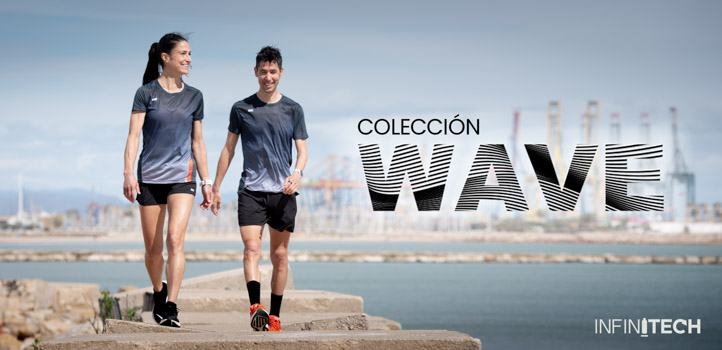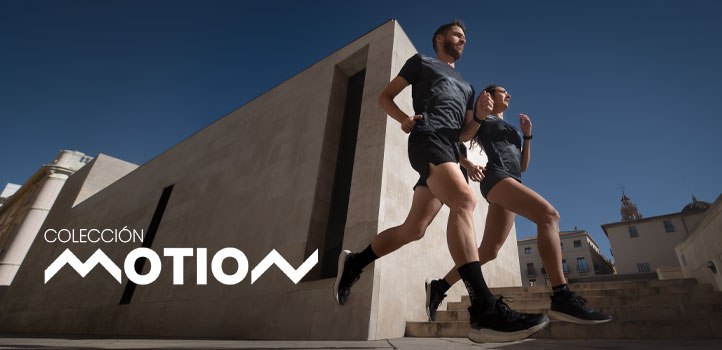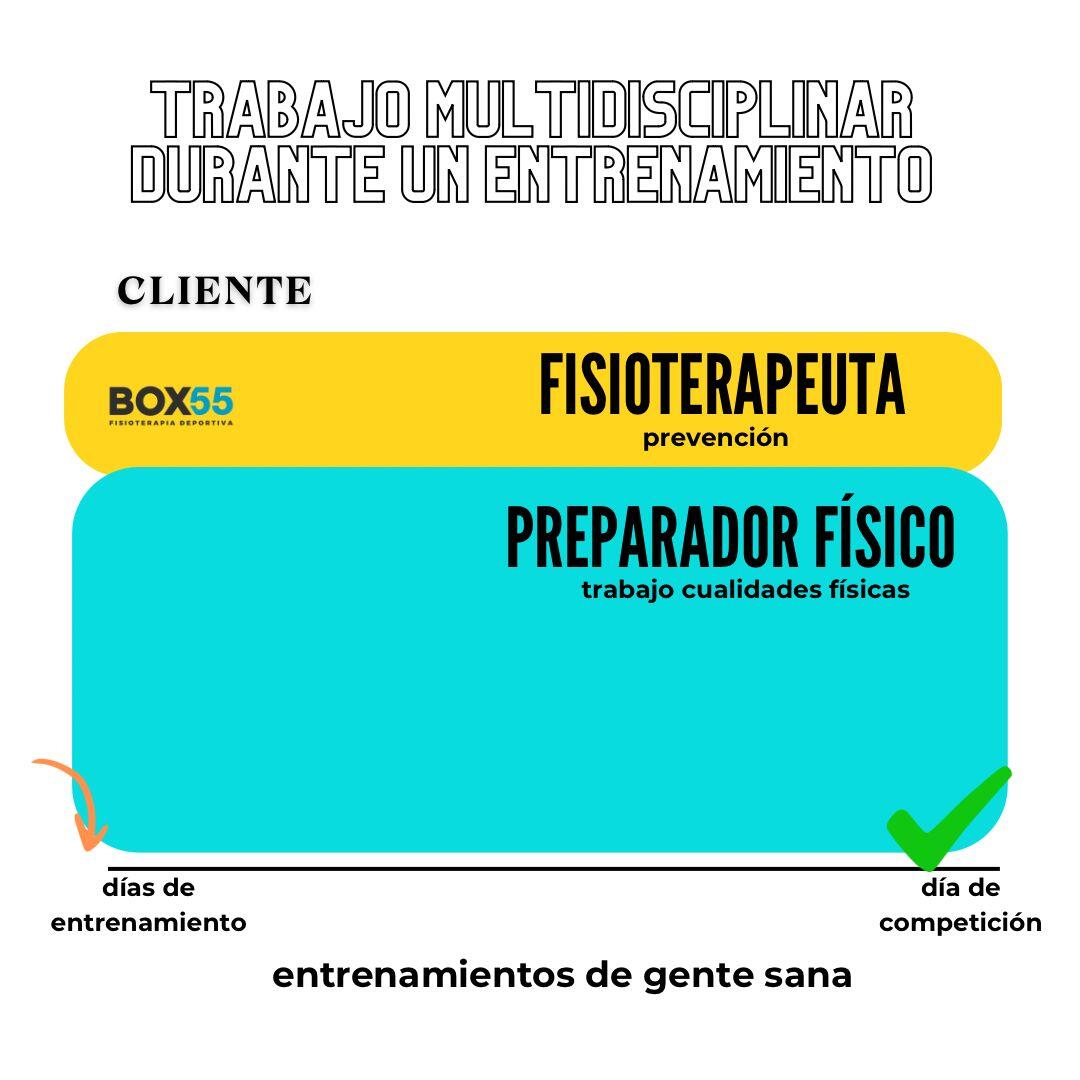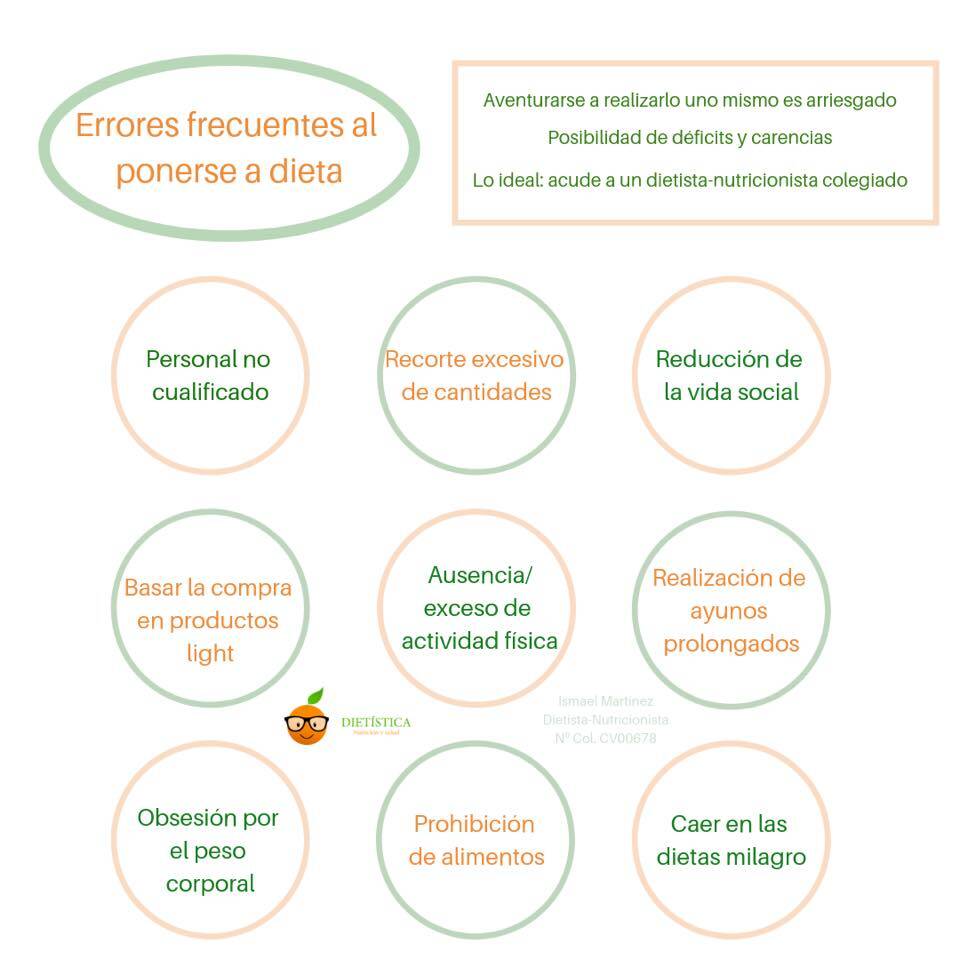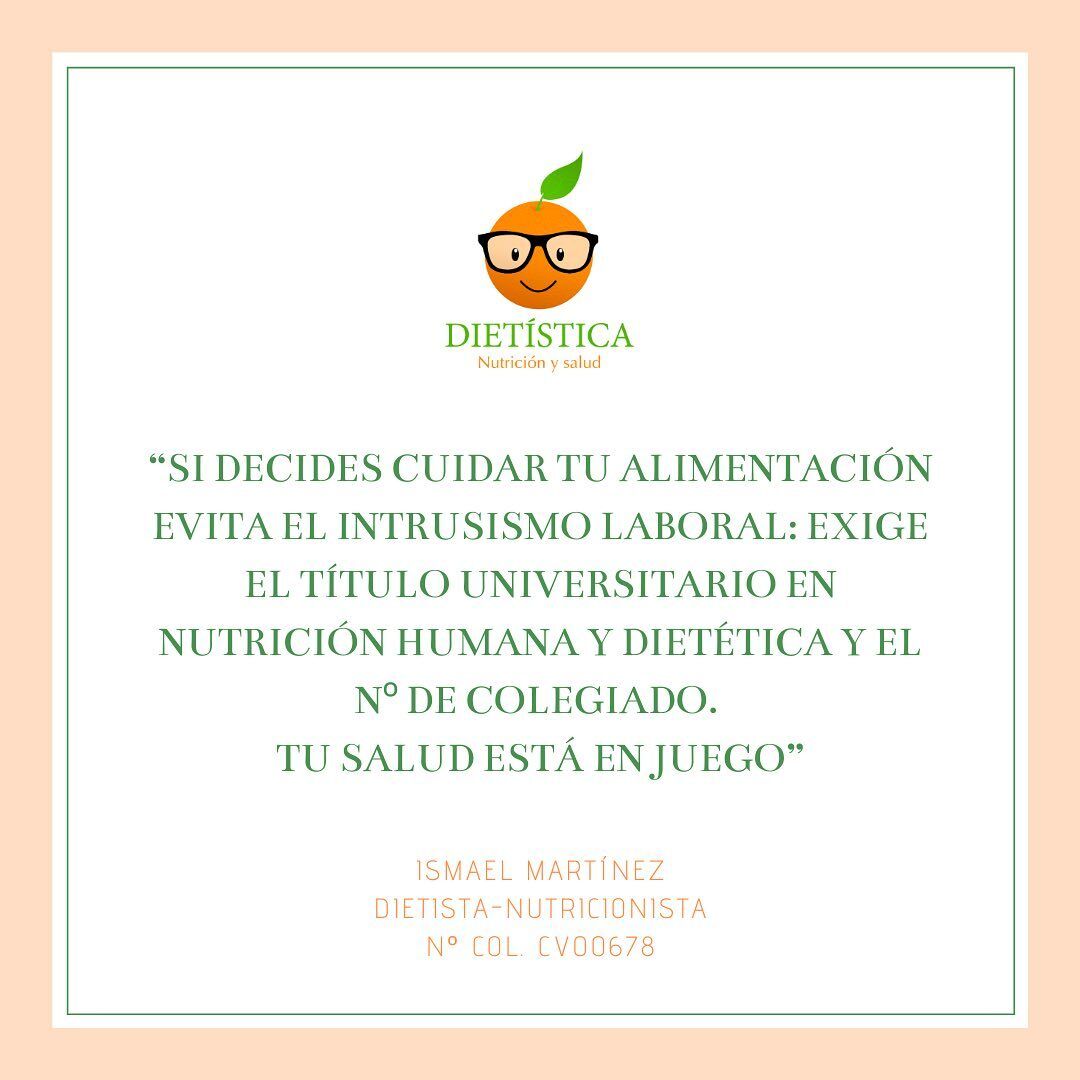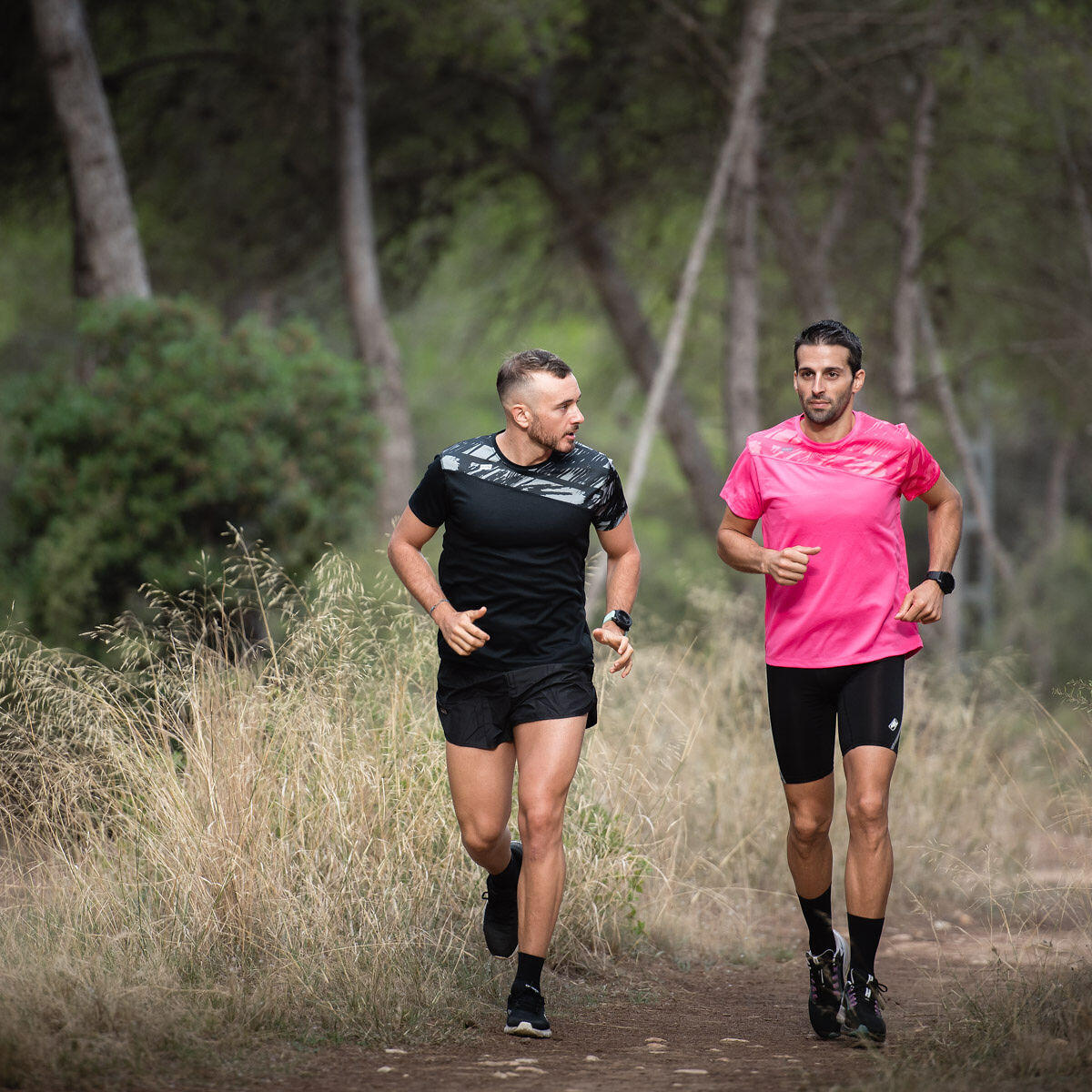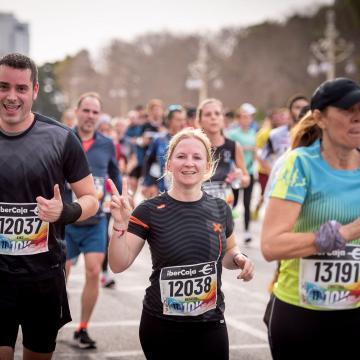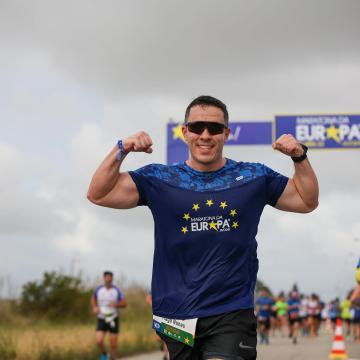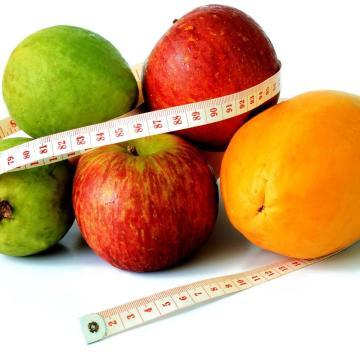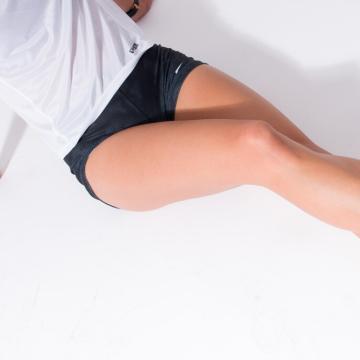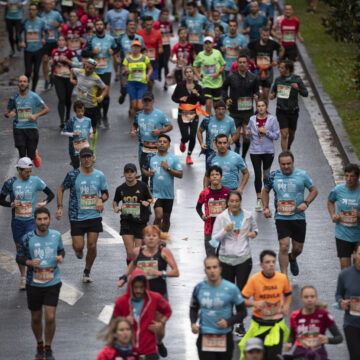Subscribe to our newsletter to find out about all the news and promotions, and automatically receive a welcome discount coupon in your email.
product -> T-shirt running recycled 42K WAVE Snow
- T-shirt running WAVE Snow.
- Technical fabric Infini_Tech made with polyester 100% recycled.
- Polyester thread obtained from the recycling of plastic bottles.
- Front with sublimated print positional with gray strokes on a white background.
- Sublimation guarantees breathability without weight gain.
- Details reflective on the back.
- Seams flat Anti-friction.
- Printed anti-scratch label.
- Anti-friction seam cover on neck.
- Treatment for fast dry “DRY-TEC+”.
- Transmission Anti-friction “SOFT-LIGHT”.
- Treatment for color fixation "DC4".
- Ergonomic front pattern with side openings.
- Rear panel longer back.
- Seated style sleeve.
- Identification label 100% recycled.
- T-shirt running WAVE Ocean.
- Technical fabric Infini_Tech made with polyester 100% recycled.
- Polyester thread obtained from the recycling of plastic bottles.
- Front with
- positional in blue tones.
- Sublimation guarantees breathability without weight gain.
- Details reflective on the back.
- Seams flat Anti-friction.
- Printed anti-scratch label.
- Anti-friction seam cover on neck.
- Treatment for fast dry “DRY-TEC+”.
- Transmission Anti-friction “SOFT-LIGHT”.
- Treatment for color fixation "DC4".
- Ergonomic front pattern with side openings.
- Rear panel longer back.
- Seated style sleeve.
- Identification label 100% recycled.
- T-shirt running WAVE Storm.
- Technical fabric Infini_Tech made with polyester 100% recycled.
- Polyester thread obtained from the recycling of plastic bottles.
- Front with sublimated print positional in dark tones.
- Sublimation guarantees breathability without weight gain.
- Details reflective on the back.
- Seams flat Anti-friction.
- Printed anti-scratch label.
- Anti-friction seam cover on neck.
- Treatment for fast dry “DRY-TEC+”.
- Transmission Anti-friction “SOFT-LIGHT”.
- Treatment for color fixation "DC4".
- Ergonomic front pattern with side openings.
- Rear panel longer back.
- Seated style sleeve.
- Identification label 100% recycled.
- T-shirt running WAVE Vulcan.
- Technical fabric Infini_Tech made with polyester 100% recycled.
- Polyester thread obtained from the recycling of plastic bottles.
- Front with sublimated print positional in red and orange tones.
- Sublimation guarantees breathability without weight gain.
- Details reflective on the back.
- Seams flat Anti-friction.
- Printed anti-scratch label.
- Anti-friction seam cover on neck.
- Treatment for fast dry “DRY-TEC+”.
- Transmission Anti-friction “SOFT-LIGHT”.
- Treatment for color fixation "DC4".
- Ergonomic front pattern with side openings.
- Rear panel longer back.
- Seated style sleeve.
- Identification label 100% recycled.
The 10k has become the popular test par excellence and for many people who are starting out in the running It is the first great competitive challenge in which to defend a number. In this article we are going to offer you tips to prepare for a 10k.
The 10k is a distance that more and more popular runners dare to do every day. The 'boom' of running In the last decade it has meant that many tests of this distance have been born and that almost all cities or towns of a certain entity have their ten thousand meter race.
In many 10k events (it also occurs in distances such as the 15k, the half marathon or the marathon) it is possible to find people who face the distance for the first time without adequate preparation to complete the test within the time allowed by the organization; The problem, however, is not arriving outside the time limit but rather subjecting the body to an effort for which it is not sufficiently prepared.
We have turned to the specialist Marcos Greus, high-performance trainer and coach in endurance sports, to ask for advice for someone who wants to prepare for a 10k (their first 10k) and do it in a sensible way and with the peace of mind of having the necessary preparation to face the challenge.
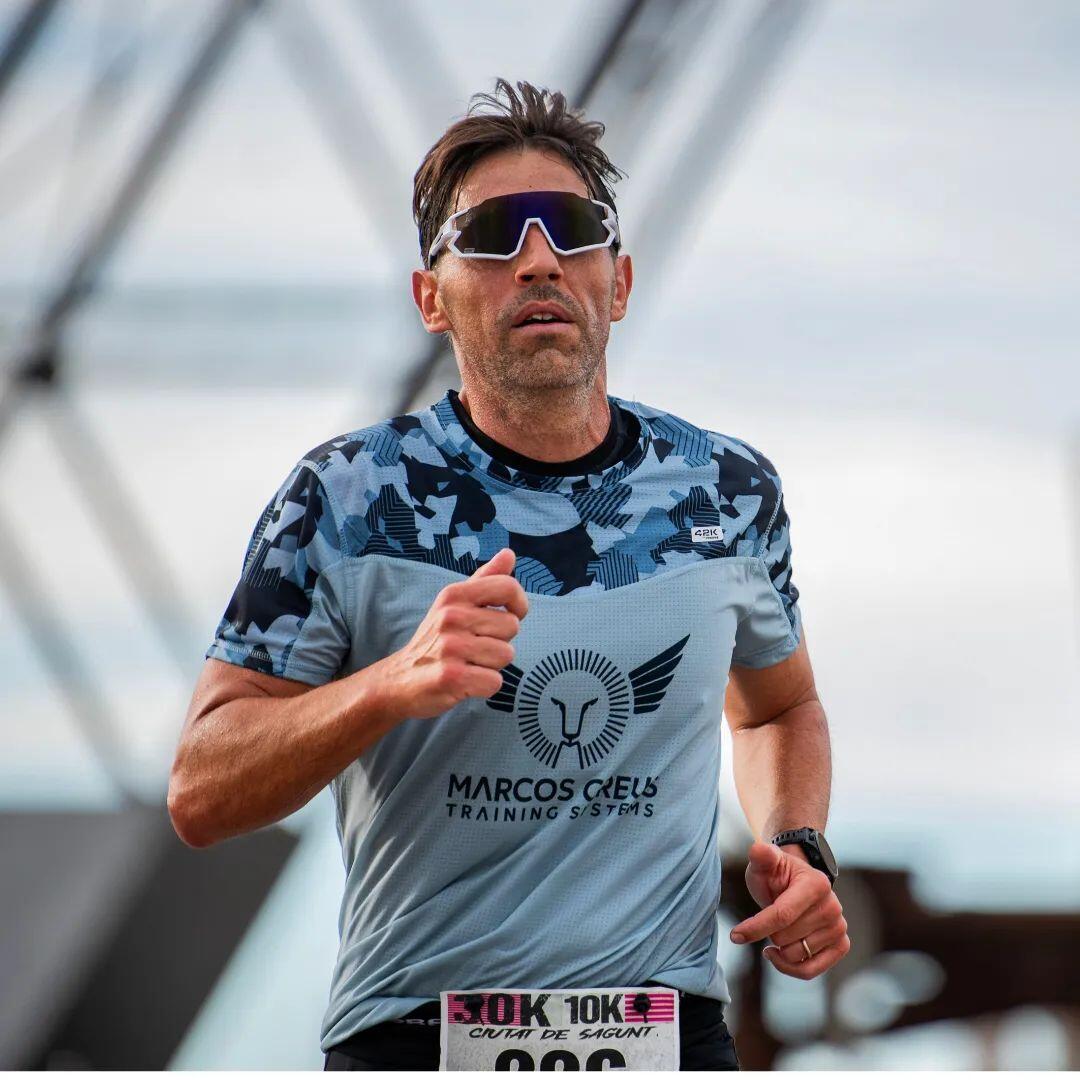
We have asked you a series of questions, taking as a starting point the situation of a popular runner who is already able to endure 30/40 minutes of continuous running, who goes out running 3 days a week and who is willing to increase your training time (plus time per shoot and adding a fourth day of training).
Preparing for a 10k requires being in shape
Preparing for a 10k is usually the first big sporting challenge for many people who get into running. runningIs it really a distance suitable for anyone?
Many people start running for health reasons, to feel well, to reach or maintain an adequate weight... As long as there is no medical contraindication, it is a good decision to start running, but running is a demanding physical activity that requires minimal preparation to avoid scares or problems; I always say that You have to be in shape to start running and not run to be in shape..
When you start running it is very important to be sure that you are in physical shape that guarantees that you are not at risk of injury.
It is more common than we think to find people who start running after a long time of total inactivity, who are overweight (with the risk that this can pose for the joints), without muscle tone and without having a prior medical check-up. And at the height of absurdity there are also cases of people who dare to run starting with popular races, which is a blunder and recklessness.
The boom of running that has been experienced in recent years has meant that many people sign up for races without adequate preparation and in some cases even without having barely run before. I have known cases of people who have signed up for races right away because they said that they found a stimulus to train and motivate themselves to run.
Prepare a 10k requires being in shape as a first requirement and, furthermore, committing to carrying out preparation work that is demanding because we are faced with a distance that seems very affordable (and really is with the right preparation) but that is not within everyone's reach because it involves running for around an hour uninterruptedly. ; It's one thing to run 20-25 minutes and quite another to run 60 minutes continuously..

How long is it advisable to have been running to consider running a 10k with guarantees of finishing it correctly and without problems or taking risks?
In general, my recommendation for anyone would be to face the challenge of preparing for a 10k when you are really sure that you can do it. run between 10 and 12 kilometers with solvency. What do I mean by “solvency”? Well, the cardiorespiratory system, the muscular system and the bone and ligamentous system are capable of supporting 10 kilometers at an easy pace; At that moment and not before is when you should think about tackling a 10k.
Many people go for their first 10k without having gone beyond 7 or 8 kilometers and, fortunately, nothing happens to the majority, but it is a distance in which there are risks that can cause discomfort or even injuries that could be avoided with a little more preparation, perseverance and, above all, patience. In recent years impatience has prevailed in the running popular; Fear and respect for distances have been lost, which is something that seems worrying to me.
When you can run 10 kilometers reliably at an easy pace, it is time to slightly increase the intensity and volume of training kilometers to face a 10k.
And why increase intensity and volume in training? Well, because in a race, inevitably, you will run at a faster pace than in training; When you put on your number it is normal to want to give your best and the body has to be prepared to run at a higher intensity.
Therefore, the sequence of steps to follow before facing the first 10k would be...
First step: Be able to run 10 kilometers with ease at an easy pace.
Second step: When you are already able to run 45-50 minutes three times a week with ease, it would be a good time to think about running a short race, 5 or 7 kilometers, to have a first contact with the competition before making your debut in 10k.
Third step: Increase the intensity and volume of kilometers to prepare the body for the highest intensity that we will demand of it on race day. How to increase the intensity? With short fartleks, such as 10 one-minute changes of pace with breaks (light jogging, without stopping) of 2 minutes. How to increase the volume? Running at a calm pace 12/13 kilometers.

10-12 weeks of specific preparation to prepare for a 10k
How long before the test would it be advisable to start training to adequately prepare for a 10k?
It depends on the starting state of each person; Starting to run from scratch is not the same for a sedentary person as it is for an active person who exercises or practices other sports regularly.
The starting state of each person will be decisive in establishing what type of training, how many days of training and what the appropriate planning should be to aspire to run a race safely and without risk of injury or health problems. .
At this point I want to claim the importance of a professional in Physical Activity and Sports Sciences being the one who determines what the optimal planning is and is also the one who guides the path of preparation; Only a physical preparation professional will be able to objectively determine what a person's starting physical state is and, therefore, what is the most appropriate preparation to face the challenge of preparing for a 10k.
In the case of an active person (not sedentary), who performs physical activity with some regularity and who does not have any physical limitations or medical contraindications, the normal period to prepare for a 10k would be 10-12 weeks of training running 3 times a week and doing at least one day of strength training.
What is essential from the point of view of a physical trainer before starting to prepare for a 10K?
Determine very well what the person's starting point of fitness is. Something very important for me is to make a anamnesis Sports, that is, an analysis of the medical history and personal and family history to be able to adjust the training loads as much as possible to the reality and circumstances of that person.
As I have pointed out before, starting to train a person who is coming from a period of inactivity (whether due to injury or disconnection from sport) or a sedentary lifestyle is not the same as starting to train someone who already does some sporting activity and who, therefore, already has muscle toning or adaptation to start with specific training focused on running.
It is essential to determine the starting point and carefully examine what is in the 'toolbox' of the person who wants to prepare a sporting goal.
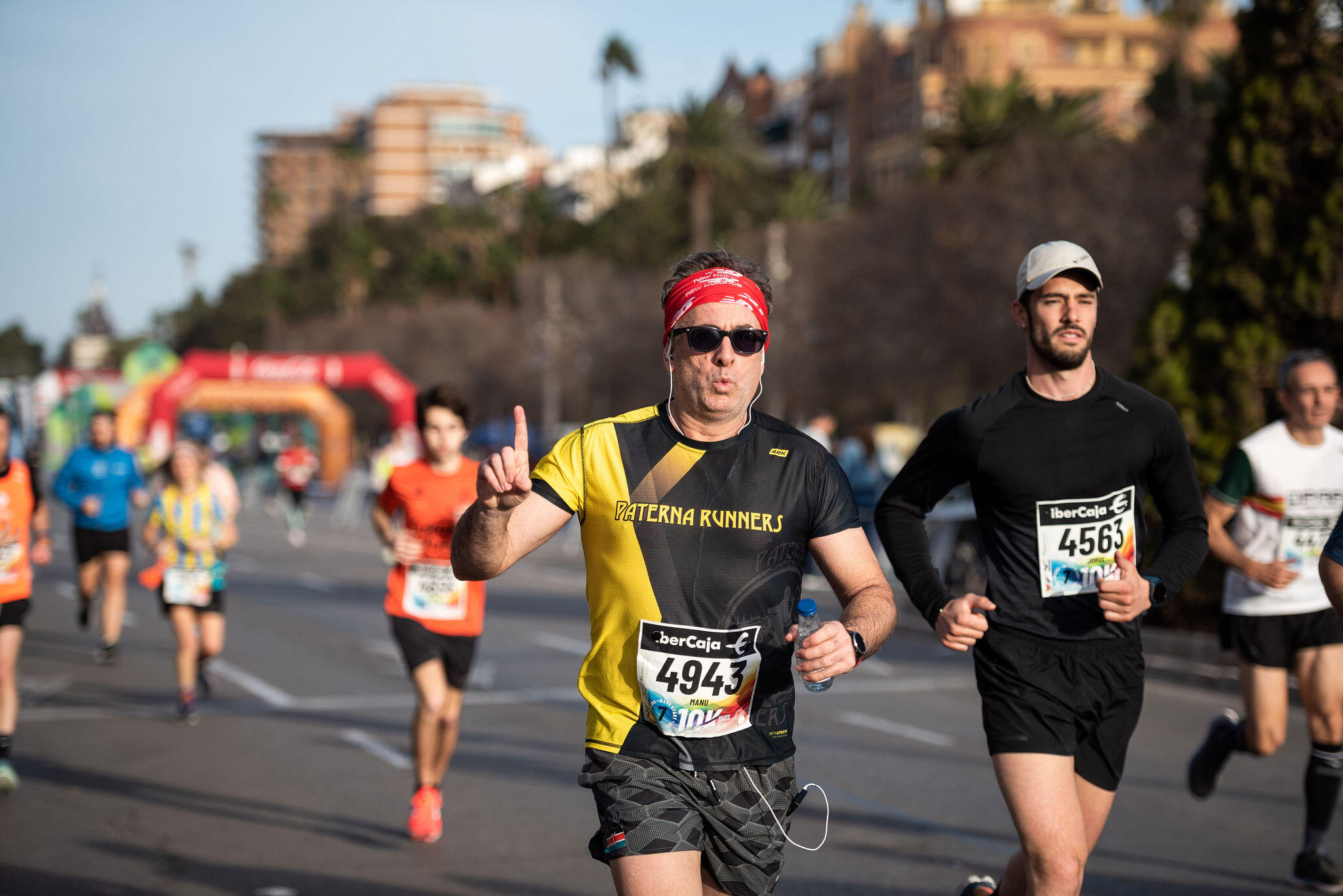
What do I mean by what's inside 'the toolbox'? I'm going to explain it with an example: person and a half on Saturday and Sunday; In person X's toolbox there is also the possibility of going to a gym for one or two days or doing a day of pool training...
With all that information, with everything I know is in person X's toolbox, I can design and build the most efficient training possible to address the sporting goal. That is why I say that for me the initial history of the person/athlete is essential to be able to properly adjust training days and workloads.
Yes, you have to train strength to prepare for a 10k
Is it important to incorporate strength training into preparation to debut in a 10K?
Absolutely yes. Strength is the basis of any physical preparation and it is important to prepare for a 10k. For someone who wants to face a 10k for the first time with the aim of finishing it with solvency but without pretensions of making a mark, specific work in the gym or with weights is not necessary, but a self loading work; This work could be with tires, TRX, on stairs, on slopes...
Strength work is necessary because it will allow train more, better assimilate training loads y reduce the risk of injury. And why do I say that it will allow you to train more? Well, because by doing strength work you can be more consistent in training and in the end the key in any endurance sport is perseverance and patience. The person who is constant, who does not skip or miss workouts, is the one who progresses.
In a 10k you take between 8.000 and 9.000 steps, which means supporting your body weight multiplied by 4 each time you step on the ground; If at the bone, muscle, tendon and ligament level you are not strong enough and prepared to withstand this enormous volume of impacts, discomfort and injuries may appear, and it will be of no use to wear very expensive shoes.
The most common mistake when debuting in a 10k: not keeping pace
What mistakes should you try to avoid when running a 10k for the first time?
The most common mistake of the beginner is usually getting carried away by the emotion of the race and not keeping track of the pace.
Act quickly. avoid going out at inappropriate paces because you end up paying for that after kilometer 7. You have to plan your pace from the start and run with a cool head at all times, but especially in the first kilometers.
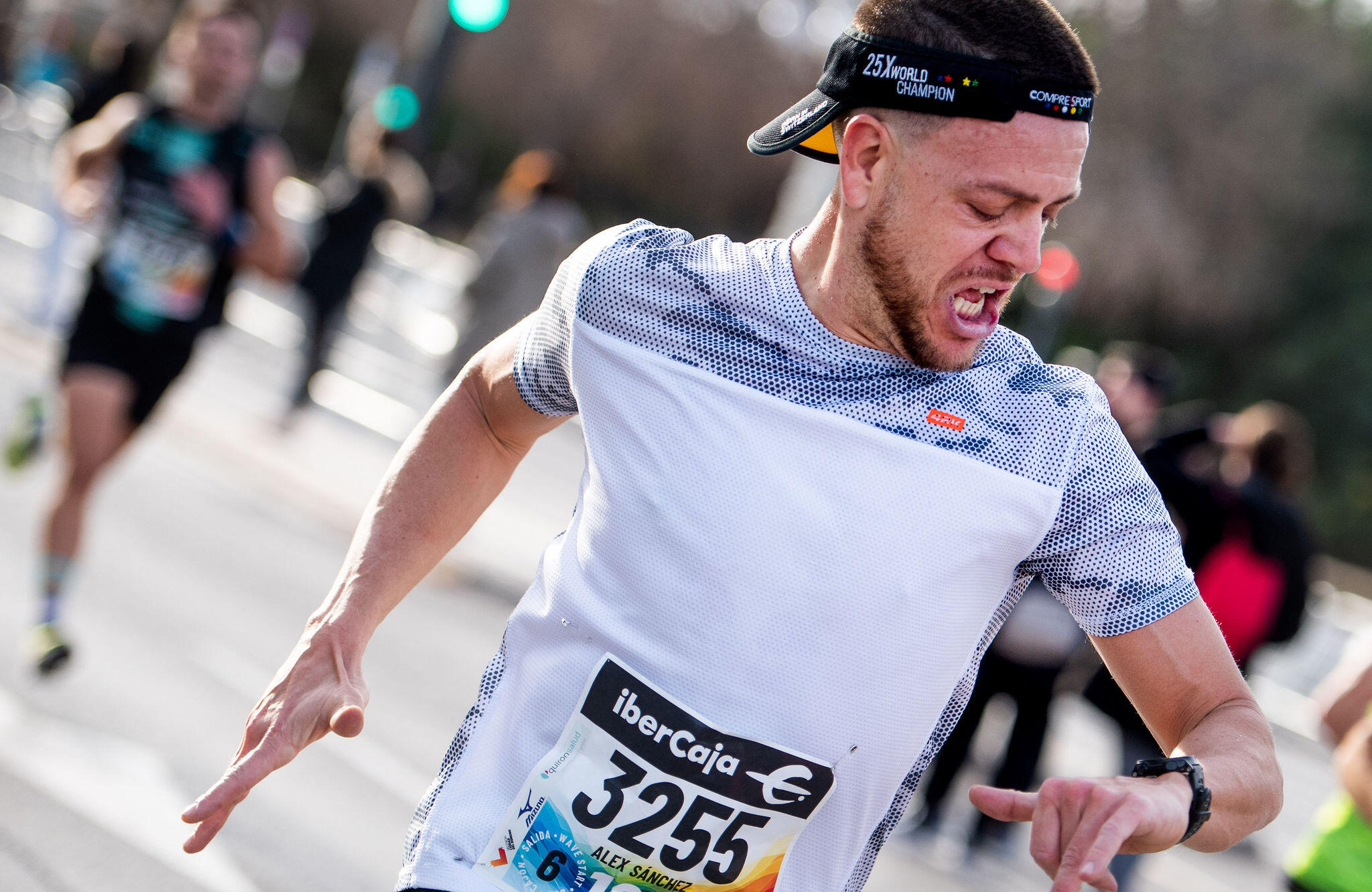
I always tell beginners in any distance, be it a 10k or a half marathon or a marathon, that you have to run at the rhythms or pulses that have been trained and assimilated. You should not overestimate yourself in the first kilometers no matter how good the sensations are; That feeling of believing that the bib number is going to give you that extra performance to run faster throughout the entire route is very treacherous.
Another indication that I always give to the runners I train is that the day before and the day of the race There is no need to do anything that has not been previously trained..
There is no need to do “experiments”. And on race day you don't have a different breakfast, you don't drink more coffee, you don't wear new clothes, much less shoes (which may sound like a joke, but I know of cases), you don't take an energy gel before the race because it's a recommendation from someone with a lot of experience, you don't drink something during the race that you haven't tried before...
On race day you don't have to do anything new; Everything that is done on race day has to be trained and assimilated prior to the race.
What would be important to be clear about before considering putting on a bib in a 10k?
The most important thing is to be clear that you want to run a race. There are many people who end up putting on a bib because of “pressure”. I know of cases of people who sign up because friends or family insist on doing so when they have been running for some time and they do it almost out of obligation.
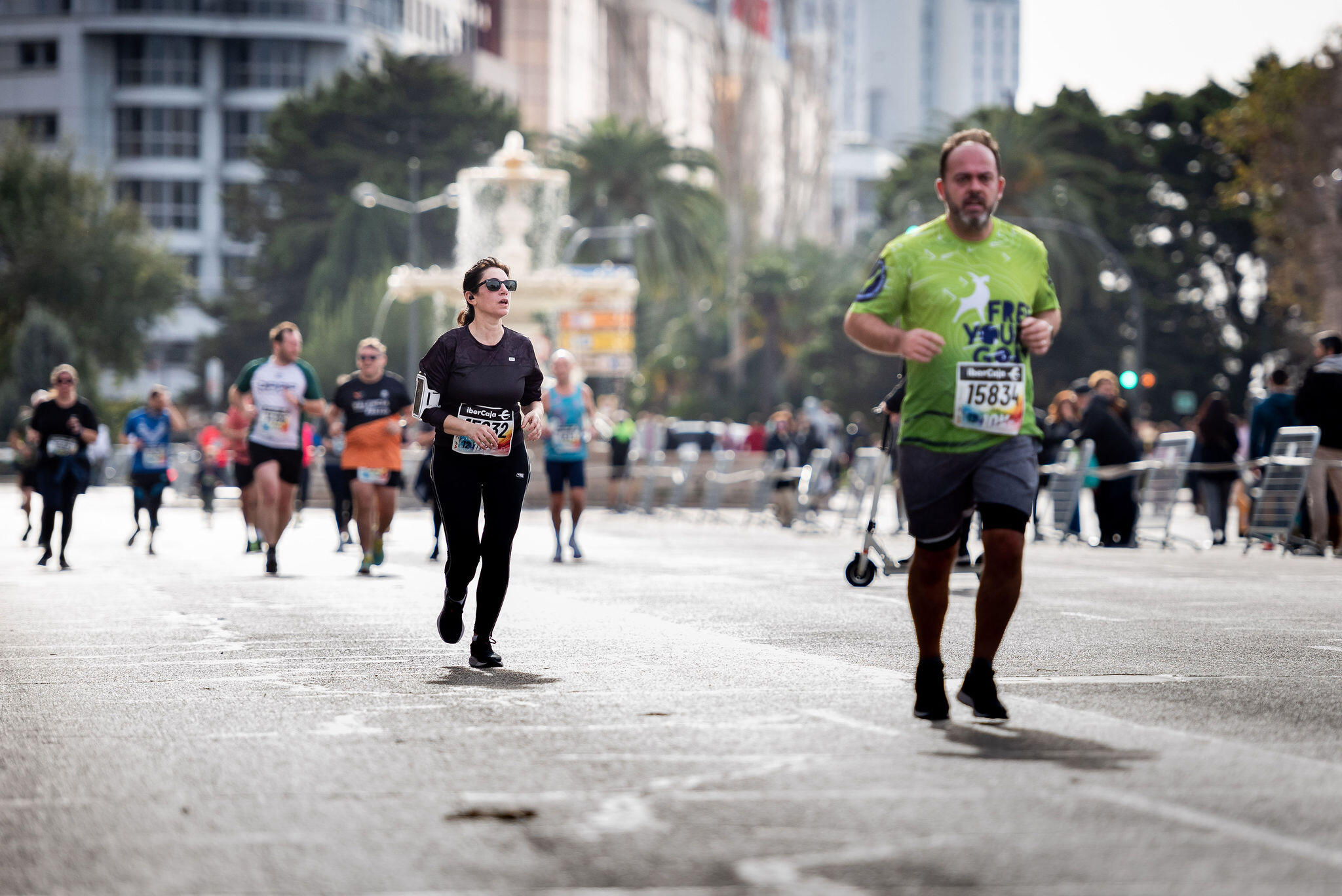
Facing a race, especially for the first time, generates stress that not everyone likes or enjoys. There are many people who like to run for health or for fun or to disconnect and who don't like to compete, and that's okay. Putting on a bib and facing a 10k is something you really have to look forward to. It is absolutely respectable that someone decides to run and has no interest in the competitive aspect.
- Shorts unisex de running RunnersHeart.
- Knitwear microlight and fast drying.
- IUT fabric (Interlock Ultralight Technology) 100% polyester compact construction.
- Elastic waistband with drawstring.
- Side openings to facilitate the stride.
- built-in slip For greater support and to avoid chafing.
- Integrated RunnersHeart sublimate.
- Printed anti-scratch label.
- Do not dry clean, do not put in the dryer and do not iron.
Do you want to improve as a runner? Put yourself in the hands of professionals. To achieve sports goals, whether elite or popular, you must seek advice from someone who can really help you with judgment, seriousness and professionalism to improve as a runner in the section of training, preparation, nutrition, injury prevention and recovery... etc.
Internet and social reds have been a infinite amount of information available to anyone who is starting out in sports, information that can be very diverse: training, sports planning, nutrition advice, recommendations for injuries...
In many cases this information comes from serious sources, but has been provided in a generic manner, without taking into account the particular case of a specific person or patient. There is also information that comes from very unreliable sources and that should be ignored because in addition to not helping you improve as a runner, it can cause problems for you.
To improve as a runner you have to seek the right advice
We live in a time in which everyone has access to information at the click of a button and in which it is very fashionable to publish content on social reds about sports, nutrition, training... and, of course, physiotherapy.
Many professionals who have studied and achieved the corresponding degrees that accredit our knowledge and, therefore, the competence to offer quality services and advice to athletes, we witness with astonishment, disbelief, patience and, sometimes, indignation at the absurdity of finding, on a daily basis, on social reds people without qualifications or degrees pontificating on subjects about which they have little knowledge.
Some even profit from their advice, recommendations and advice based on knowledge that they do not prove (probably because they lack the required qualifications). Unfortunately, many of their clients are not aware of the risk they run by putting themselves in the hands of people who advise on training-preparation, injury recovery, nutrition or physiotherapy without training and without qualifications to prove their competence.
I am going to try to clarify which professionals can help you achieve your goals (and therefore improve as a runner) and which false professionals put your health at risk due to lack of preparation, lack of knowledge or desire for prominence.
In my opinion there are two basic rules to start dealing with this topic:
- Practicing a sport does not make you a professional specialist in it.. For example, no matter how good you are at playing soccer, you are not a coach; No matter how good you are at CrossFit, you are not a CrossFit coach; and, logically, no matter how good you are at running and no matter how good a time you have in the marathon or 10K, you are not a sports coach. running/athletics.
- The type articles… «7 definitive exercises to have iron legs» o «training to lose 50' in 10K» o "core training to be a better runner" that you find on the Internet or on social reds are not the ones that are going to be best for you (they may even harm you); They are articles written for other purposes (improve positioning, improve visibility, attract attention, gain followers...) but they are not really designed for you.
My advice is that you look for a true professional who is trained (and qualified, because that is a guarantee of having acquired knowledge), updated and, above all, who has experience in what you are looking for, be it training-preparation, nutrition or physiotherapy. If you really want to improve as a runner, don't put yourself in the hands of people

Without health there is no achievable goal
I frequently see people on social media offering information about physiotherapy or injury recovery (which is my professional specialty) without any criteria and, worst of all, without taking into account that giving inappropriate advice can lead to physical problems and even injuries. And injuries, I know from professional experience, destroy people's dreams and sporting aspirations. A phrase that I repeat ad nauseam with my patients and also when I teach classes is "without health there is no achievable goal".
With this article I intend to clarify the role of each of the professionals that you may encounter as a runner in your sporting activity (and to improve as a runner it is very important to be clear about this).
The first thing I want to make clear is that If you have an injury, you should go to a medical professional. to diagnose the injury; From there, I consider it very important to clarify the distribution of roles between physiotherapist, physical trainer and coach:
- Un physiotherapist trabaja so you can train.
- Un physical trainer trabaja so you can compete.
- Un coach trabaja so you can perform.
Are you a patient or client? An important difference
A very important aspect to keep in mind is to know if you are a patient or a client, what difference does it make? Well, very simple: if you are injured or need to prevent injuries In order to train, the professional you should turn to is a physiotherapist, because you are a patient. If you are healthy, you are a client and what you need is a degree in Physical Activity and Sports Sciences.
If you are a patient, you need a physiotherapist
The physiotherapist is the professional who is in charge of improving the injured structure while respecting the tissue healing process; In addition, it works on the sports rehabilitation of the injury or preventing it, based on physiotherapy tests that help ensure that you can train without pain or discomfort to give quality to the training of sports professionals, who are the physical trainers of yesteryear and who Now they are graduates in Physical Activity and Sports Sciences.
A physiotherapist accompanies the athlete when he is injured; and when he is not injured, the physiotherapist can help him prevent with exercises evaluated through functional physiotherapy tests, for example with the Valobando App (you can learn more about what it consists of in the article «The importance of the sports physiotherapist»), generating specific work for the athlete with a health objective, since they are health professionals.
A physiotherapist can make a physiotherapy diagnosis, which, together with a previous medical diagnosis, serves to design recovery work and also serves to avoid relapses.
If you are not injured, you are a 'client' and need a degree in Physical Activity and Sports Sciences
The graduate in Physical Education or currently the Degree in Physical Activity and Sports Sciences is the professional who is in charge of preparing the runner who is healthy (not injured) to compete. If you are not injured, you are not a patient, but a client with a competition goal in mind.
The graduate in Physical Activity and Sports Sciences is the professional who is in charge of, once your physical qualities have been evaluated, preparing you so that you can compete to the maximum and improve as a runner; he is in charge «to look for your best version», which is an expression that is very fashionable now. To improve as a runner, it is essential to have the advice of an expert in physical preparation to be able to get the best out of your physical qualities.
Furthermore, a graduate in Physical Activity and Sports Sciences who is specialized in high performance in endurance sports is the one who can best guide you in planning training to achieve a specific goal.
Now, can a physical trainer readapt an injury? And a second question: can you train a patient with an injury?
The answer to the first question is a resounding NO because it has not been trained for it; Doing so would be a clear example of work intrusion, in addition to putting the 'patient's' health at risk, because a runner who requires rehabilitation due to an injury is a patient and not a client (which is why I previously made the distinction between patient and client).
The answer to the second question is more complicated, but I will try to clarify it: a patient (a runner with an injury) must be supervised by a physiotherapist in the stretcher and readaptation phase to the sport, but is not exempt from working on the physical qualities that your sport requires and that is the part in which the Physical Activity and Sports Sciences technician intervenes, but always under the supervision and tutelage of a physiotherapist.

The physiotherapist and the degree in Physical Activity and Sports Sciences go hand in hand in the training and recovery process of an athlete. It is a professional tandem that can really help anyone interested in that goal improve as a runner.
Once the runner has recovered from the injury, the person in charge of directing the training process is the graduate in Physical Activity and Sports Sciences, but the physiotherapist is obliged to generate the correct situation to that the athlete does not get injured and can train to the maximum with his coach.
At this point I would like to talk about other professional profiles (for some of them it would be more appropriate to talk about 'pseudo professionals'), especially because in recent years they have proliferated on social reds giving all kinds of advice to runners (preparation, nutrition, training, injury prevention, injury treatment, health advice...) and, honestly, I think that many of them cannot help you improve as a runner.
- Massage therapist. Person who has studied a course on how to give massages, but cannot treat pathologies because they have a very poor knowledge of anatomy. You have ‘customers’; You can go to it simply to release muscle tension, but not if you have an injury or pathology.
- Chiropractor. The chiropractic It is based on practices and beliefs that are considered pseudoscience. They are dangerous because with little training in anatomy they manipulate vertebral joints and that can pose risks to people's health.
- Monitor. There are two kinds:
- Room Monitor or Personal Trainer. Normally it is a Higher Technician in Physical and Sports Activities (TAFAD), a Vocational Training qualification that is included within the branch of Sports; They train for two years, but logically they do not have the knowledge of a degree in Physical Activity and Sports Sciences. It is a hybrid between the professional who wants to get the most out of you and get you in shape. There are also 3-month courses, it is a course with little training and low quality.
- Monitor of disciplines such as Pilates, yoga, boxing, swimming, paddle tennis, tennis, etc., they are professionals in activities specialized in a method or sport.
- Druid, shaman, brujo, neighbor with powers, friend who reads hands… They are people who help spiritually and really only help those who believe in superstitions.
- Acupuncturist. Person who inserts needles to perform acupuncture treatments; Not to be confused with physiotherapists or doctors trained in traditional Chinese medicine.
- Expert in nothing and everything. This is a dangerous profile: his sporting experience is all his knowledge and he believes that this qualifies him to coach others. Unfortunately, I have had several examples in my clinic of runners injured by following the advice of that friend. "who has been running for many years and has won several popular races", which is why he considers that he can serve as a coach for anyone.
- Youtuber, content creator, influencer… This is a profile that has grown on social reds and that, in my opinion, has every right in the world to generate content as long as it does not delve into professional fields that have to do with health, and for me health It is nutrition, training, physical preparation, injury recovery, physiotherapy...
In conclusion, I believe that health must be taken very seriously. In general, most true professionals are respectful of their areas of action. Specialization is essential to provide health guarantees to athletes. A physiotherapist cannot delve into the terrain, for example, of a podiatrist, in the same way that a traumatologist cannot act as a nutritionist or a physical trainer cannot determine how recovery from an injury should be done.
- Sleeves RunnersHeart for running.
- Sleeves with exclusive customization through.
- High stretch lycra, lightness y breathability.
- Very soft fabric.
- Adaptation to any type of arm.
- Silicone band inside for better support.
- Logo 42K reflector in fluorescent orange.
- Available in two sizes unisex: S/M y L / XL
- They are not compression sleeves.
Many popular runners make the decision to start a supposedly healthy diet on their own and, generally, they tend to make different mistakes.
Starting to take care of yourself to improve your quality of life and even to have a healthier appearance (body) is very good and should be applauded. But experience has shown me that most people who start a healthy diet on their own they end up making different mistakes because they lack the necessary training to know the what, how and when of a healthy diet.
Some of the mistakes that are often made when starting a healthy diet without the supervision or advice of a nutrition professional can be harmful to health and end up interfering with the achievement of the objective of improving the general state of health and even not achieving the desired change in physical appearance.
10 common mistakes when eating a healthy diet without professional advice
Nowadays social reds are full of 'nutritional influencers', 'nutritional coaches' or 'nutritional therapists'; These people, many of whom lack the necessary qualifications, earn money by generating content on nutrition, among which there are many recommendations/tips/advice on healthy diets (some dare to go even further by talking about "miracle diets"). which can be dangerous to health because they can cause serious nutritional imbalances.
The only health professional authorized to carry out dietary plans is the dietitian-nutritionist.
Based on my experience in consultation, I am going to list the main mistakes that are usually committed by people who decide to start a healthy diet (or what these people consider to be a healthy diet) without the advice, supervision of a dietitian-nutritionist.
These would be the 10 most common mistakes that are committed when starting a supposed or supposed healthy diet that has not been planned by a nutrition professional:
- Reduce intake.
- Reduce social life.
- Buy only atlimelight type lenses.
- Excess physical activity.
- Absence of physical activity.
- Carrying out prolonged fasts.
- Obsession with weight.
- Removelimentos by false myths.
- Falling into “miracle diets.”
- Do not resort to a nutrition professional.
A healthy diet is not eating less or eating only 'light'
Reduce intake
It is clear that the quantities will probably have to be cut a bit, but The problem is not 'how much' but 'what'. I'm going to give an example: a donut is small, but its caloric value is very high and the nutrients it provides are not healthy. However, a salad is a larger amount of food but with low caloric value and a wide variety of nutrients. Therefore, a suitable option to start a healthy diet.
Decrease social life
"I'm not going to dinner with my friends because I'm on a diet.". Mistake! In one tolimeBalanced ntation there is room for whims, of course.
If you have to spend 4 months losing weight and you are not going to try chocolate in that period of time, you will probably abandon your goal and not achieve the expected results. One has to enable 2-3 free intakes per week “for mental health”, for example, going out to dinner with your partner on Friday, family dinner on Sunday and lunch with co-workers, of course, without abuse and compensating for it with good nutritional behavior the rest of the week.
buy fromlimelight type nts
Focus your shopping list on takinglimeReal ingredients, natural and quality ingredients. To follow a healthy diet you have to know how to choose foods in the supermarket.limeadequate foods and for this it is highly recommended to know how to read labels or nutritional information; If you have questions, you can consult the article that also appears in this blog about labeling to make an appropriate purchase. Example: light mayonnaise is still unhealthy, but a natural tomato and basil sauce is magnificent.
It could be said, therefore, that a healthy diet begins with the purchase we make. at the supermarket.
Healthy diet and well-planned exercise
Excess physical activity
“I'm going to run for a long time, super fast and when it's hottest” o “I'm going to go to the gym 2 times a day”. If you are cutting out food and training like an elite athlete, I'll probably give you a 'bird'.
Furthermore there is also the phenomenon of overtraining, which in extreme cases can be chronic. Start with short walks and gradually gain shape to gradually increase the hardness of your sessions. Ask the gym monitor for help and he will guide you little by little. Don't start the house on the roof!

Lack of physical activity
The opposite is also the case, doing nothing and entrusting everything to the diet. At first it works, but you will stagnate before or after. The trick is not to reduce and reduce the kilocalories we consume, but to increase our caloric expenditure with physical activity.
Additionally, with diet alone you will probably lose muscle mass. The key to success: add diet and exercise.
Performing long fasts
This dangerous fashion, so to speak, is not not at all recommended in what we would understand as a healthy diet.
Carrying out prolonged fasts triggers the hormone cortisol and represents a protein depletion which leads to a loss of muscle mass and body fat. Furthermore, when we eat again we will be very hungry so it is likely that we will overeat which will activate the excessive secretion of the hormone insulin, which it will create fatty tissue.
Weight obsession
What the scale says is not the most important thing. Sometimes weighing the same is not a problem because you can lose 2kg of fat and have gained 2kg of muscle mass because you have started training. At that moment you will overwhelm, but your body composition is much better. Look in a mirror and check your clothes, you will see that your volume is much smaller!
In addition, weighing yourself daily is a mistake, because it is possible to appreciate that in one or several days you do not go down anything and even go up ... do not panic! You may have to go to the bathroom, that you have weighed at different times, that you are in the menstrual period (in the case of women) and many other factors that influence body weight.
Removeliments for false myths
"I follow a healthy diet and I don't eat bananas because I've been told it makes you fat"; "water in food is very bad" o "bread, pasta and rice outside, carbohydrates are very bad"… These are phrases that are frequently heard (there are many more of these popular statements circulating out there among popular runners when talking about a healthy diet). There are many false myths in relation to thelimentation and let alone when it comes to talking about a healthy diet.
There is nothing wrong with, for example, some oil and salt toast for breakfast; There is also no problem in having a banana for lunch or eating a plate of rice with chicken and vegetables. Please, Don't believe everything you read on social media!
There are too many false myths in relation to what a healthy diet should be and, for some time now, it is very worrying to observe that many of these false myths are spread uncontrollably.
Be very careful with miracle diets because they are the opposite of a healthy diet
Falling for miracle diets
«I have stagnated in weight so I am going to do the artichoke diet» o "I'm going to live on juices and smoothies for a month": They may seem like unrealistic atrocities, but they are crazy things that some people do who believe in the miraculous effects of some diets (which is why they are called 'miracle diets'). These diet They promise great weight loss quickly and effortlessly, something that some of these diets can fulfill but paying a very high cost for health.
Miracle diets They are an error due to excess restriction, so there will be important shortcomings, but above all because the lost weight is usually regained. Why is this happening? Because they don't teach you how to eat well; There is no nutritional education, so when you are at your weight you won't know what to do to maintain it.
Remember: any miracle diet is just the opposite of a healthy diet.
Not turning to a nutrition professional
Generally, all the patients who come to my office have already decided to start a healthy diet for themselves, or they either fail to achieve their goals or they quickly stagnate. The only health professional authorized to carry out dietary plans is the dietitian-nutritionist, as stated in art 7 section g of the Law 44/2003, of November 21, on the organization of health professions:
g) Dietitians-nutritionists: University Diplomas in Human Nutrition and Dietetics develop activities aimed atlimentation of the person or groups of people, appropriate to their physiological and, where appropriate, pathological needs, and in accordance with the principles of prevention and public health.
The alimentation is a very important aspect of health, so a bad onelimentation (a bad diet) can put health at risk, so it is essential to entrust these matters to the appropriate healthcare professional. I would like to finish by leaving a question for any runner to answer: when you suffer a muscle problem while running, do you go to the pharmacist to get the solution? If you suffer from a muscle pull, do you ask a dietitian-nutritionist to give you a massage? It's weird, right?
Indeed, when you have a muscle problem you go to the physiotherapist, who has studied how to solve or treat these problems in the correct and appropriate way for your health. Well, when it comes to following a healthy diet you should put yourself in the hands of a dietician-nutritionist and not trainers, pharmacists, traumatologists or physiotherapists.
The days before a marathon can be very stressful, especially for runners who are making their debut in the distance. In this article I am going to give you 10 tips for your first marathon, Especially for the days before and for the day of the race.
Preparing for a marathon requires a good training plan; a training plan adapted to the objective pursued in the race, previous experience in marathon distance, state of form, age... There are many factors that can be important when determining the most appropriate preparation to face a marathon with guarantees.
We are going to assume that you have completed the preparation and that, therefore, you arrive with your homework done in the days prior to your big date with the 42,195 kilometers. Behind you have left months of training, sacrifice and effort. The day for which your legs have traveled hundreds of kilometers is approaching, the day that seemed far away in time and that now you see so close.
You must be optimistic and think that all the hours and all the kilometers of effort and dedication are going to pay off, but It is important that you do not make last minute mistakes (in the last days and on the day of the race) that could compromise the work done for months. Below I am going to list 10 tips for your first marathon that will help you avoid making mistakes.
The first of the tips for your first marathon: rest and disconnect the days before
In the days before the marathon you should try don't stress your body anymore and give priority to rest and disconnection.
If you have been rigorous and constant with the preparation, you have to be confident and seek peace of mind. It is the time of Tapering or set-up. You have to change the “I have to get up to train” by “I have to sleep more”; forget the gym and visit the physio to give you a muscle relief massage on your legs; Dedicate time to family or leisure and don't think about training anymore.
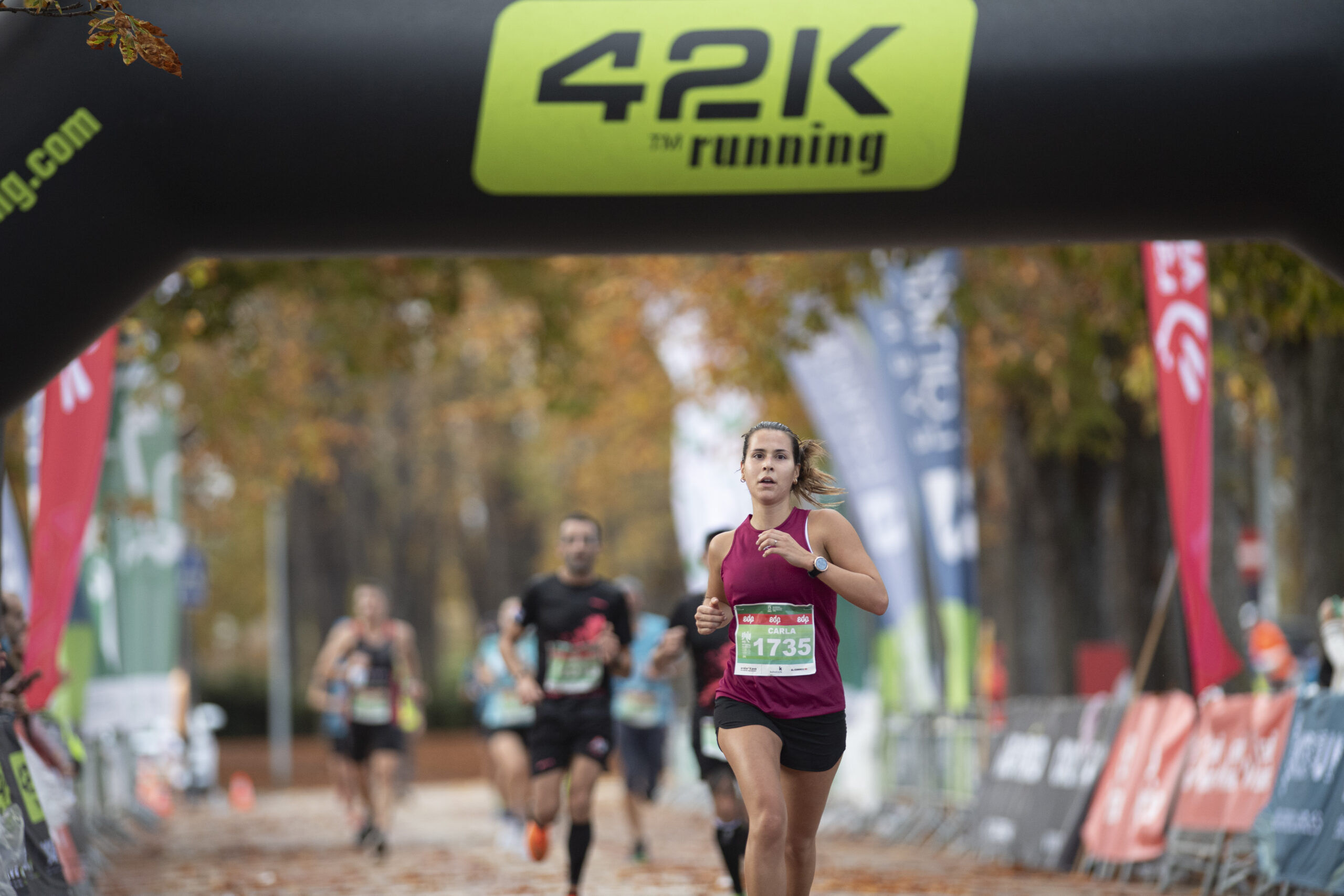
Every runner wants to arrive in the best possible performance conditions on the big day and to help you I offer you 10 tips for your first marathon. These tips for the days before and on the day of the race are valid for any runner, also for beginners:
- Don't train anymore.
- Study the weather forecast.
- Avoid staying cold on the way out.
- If you can, train at the same time as the test.
- Avoid excessive carbohydrate loads the days before.
- Eat and drink what you have trained.
- Follow the rhythms you have planned and trained.
- On race day nothing is improvised and nothing is released.
- Pay attention to small details.
- Your fans must wait for you in the final ten kilometers.
Don't add last minute training
1. Do not train more than planned by your coach. The sessions, competitions, lengths or series that you did not do are already behind you and it is not the time to recover them. Don't think about what you “could have done.” In the week before, additional training will not make you perform more or better on the day of the marathon; however, one session less may do the trick. The really important thing now, when you are just a few days away from the big date, is to arrive rested at the start. Trust what you have trained!
2. Check the weather forecast and temperature in the city where you are going to run. It is important that you know what the average temperature is at the start time and what temperature it will reach during the race (in the Valencia marathon, for example, in the month of December the average temperature at the start is 9º). -13º, reaching 17º-20º maximum). It is also advisable that you take into account the relative humidity or if there is a forecast of rain to avoid surprises.
The humidity thing is not nonsense because for a person used to training in a dry climate it can be a significant handicap to run a marathon in a more humid city or region since it will require a special hydration strategy. I'll give you a concrete example: if you live in a dry region and decide to run the Valencia marathon, which is a city with an average relative humidity of 60%-63%, I recommend that you raise your hydration levels 2-3 days before the race at 2-3 liters per day.

3. Avoid staying cold on the way out. Don't forget some clothing to keep you warm until the moment you start or until you have warmed up a few kilometers after starting to run. There are races in which it is possible to get rid of these clothes at the start or even later and that have a charitable purpose, as the organization of the Valencia marathon does, which collects all these clothes and donates them to an NGO.
4. Train at the same time as the marathon. If possible, it is recommended that you train at the same time that you are going to have to run on race day. Our body is like a “repetition machine”, capable of adapting and memorizing any routine. If due to personal or work circumstances you cannot train at the time of the test, go out for a light jog of between 20 and 30 minutes the day before the race, at a time similar to the start of the test; This way you will get your body activated the next day without problems.
5. Avoid excessive carbohydrate loads in the previous days. The belief is too widespread that it is essential to gorge on carbohydrates 48 hours before running a marathon. My advice is to avoid excessive and uncritical 'carbohydrate loads' in the days before. It has been shown that these diets are not as effective as was believed and that can cause gastrointestinal problems to many runners and runners.
Start race day with your regular breakfast (not a breakfast with “extras” for the race) and do not leave your stomach empty until 90 minutes before to start running. Bring something to eat and drink until there are 90 minutes left before departure and this way you will avoid feeling hungry or feeling 'empty' or 'lacking strength'.

On race day don't improvise with the alimentation, hydration or rhythm
6. Eat and drink what you have trained. One of the most important tips I can give you for your first marathon is to
the day of the race you don't have to improvise with thelimentation and hydration. Repeat the supplies you have rehearsed in training; stick to what you know has worked well for you in training and don't make last minute changes. The marathon is a race that is very tiring and pushes you to the limit, so you cannot allow yourself "experiments" that you do not know how they will affect your performance.
Something that I consider important to note is that many marathons have a sports hydration/nutrition brand as a sponsor or collaborator and they offer their products at the aid stations. Find out what that company is and try if those products work well for you, if you intend to use them in the race. Otherwise, continue with your personal supplies and do not eat or drink more or less than what you have planned, trained and assimilated.
It is quite common to want to eat more than necessary hoping to perform better or, on the contrary, not reach the recommended intake due to the nerves and anxiety generated by the marathon. Eat when you are not hungry and drink before thirst appears It is the key to not having energy and/or hydration problems.
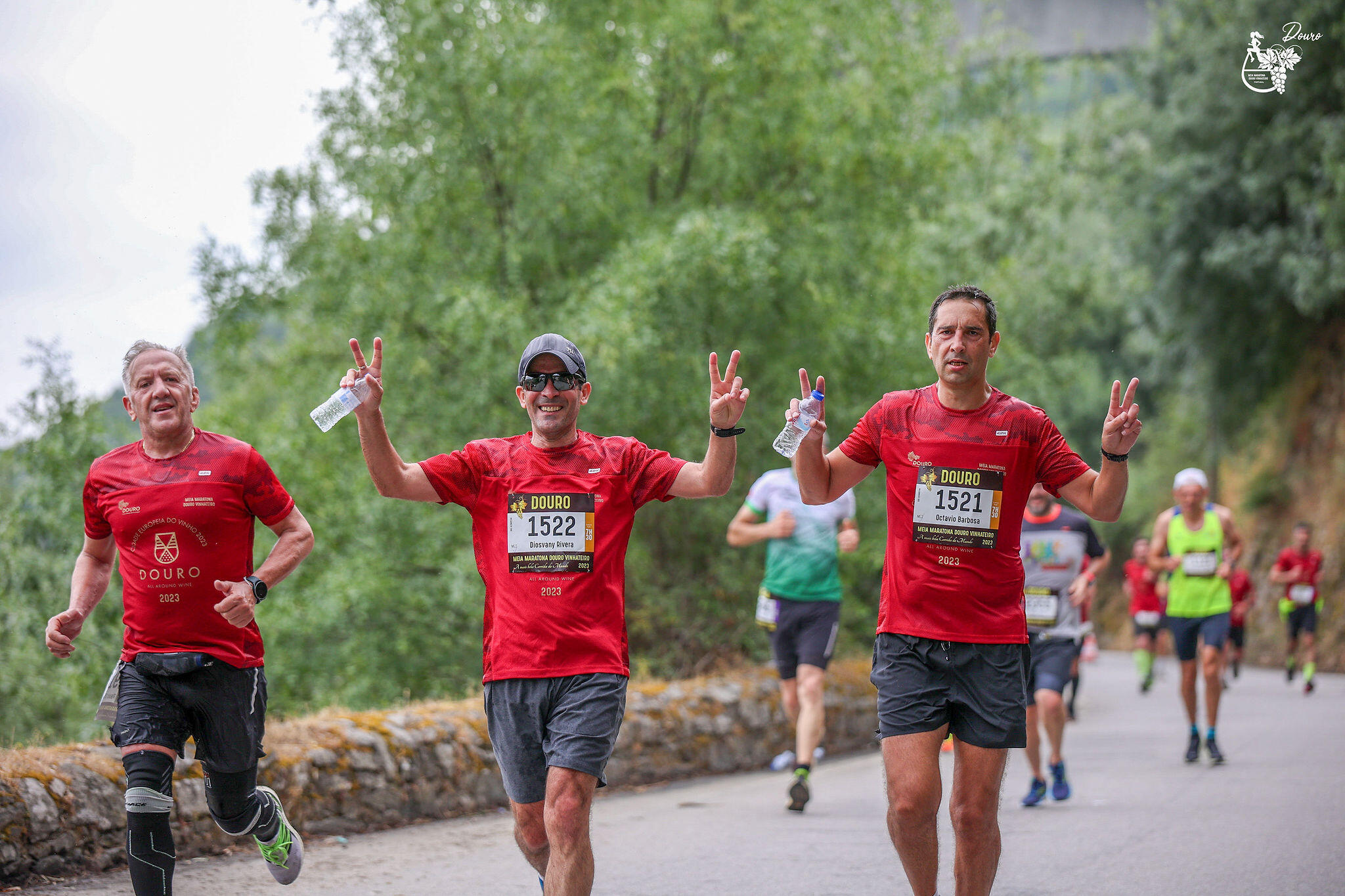
The marathon begins when crossing the starting arch, not at Km30
7. It is ESSENTIAL to follow the planned and trained rhythms and/or heart rate. You are facing a race of several hours, so you have to think that the sensations you have at kilometer 5 may be very different from those at kilometer 25. Try to be very rigorous in monitoring your rhythms and/or heart rate. planned and trained for the race; Do not get carried away by the pace of other runners because the race is very long and you will lose control (relative) of fatigue.
Among the tips for your first marathon, I also consider it important to tell you that you have the very cold head in the first kilometers of the race to avoid sudden changes in pace that usually occur in the first 3-4 kilometers. Those sudden changes of pace can wear you down more than you imagine and take their toll on you in the end. Focus on running at the pace you have planned from the start and don't mind being passed by other participants on the right or left; you have to do your race from start to finish.
It is a very common mistake in the first kilometers to run at a faster pace than expected, either due to nervousness, the excitement of the marathon, or the effect of the tapering, etc. These excesses, once the race is advanced, can cause a situation of excessive exhaustion with many kilometers to go. This state is not reversible and there is no other alternative than to lower the intensity and not lose focus on arrival.
The marathon does not start at Km30, as they say; What you do from Km1 already conditions everything that will happen later. The marathon begins when you pass through the starting arch: keep this idea as one of the main tips for your first marathon.
8. Don't improvise or try anything new. Don't experience race day! This is one of the most important pieces of advice for your first marathon that I can give you and you will surely have heard it from all the trainers or coaches in the world.
the day of the race You should NOT wear brand new sneakers, socks, pants, t-shirt... Of course, You should NOT try new isotonic and/or energy drinks; Don't try any radical diets in the last few days (even if so-and-so or so-and-so did wonderfully in a previous marathon).
Another piece of advice for your first marathon that I consider necessary to highlight is the importance of not doing training with new teammates the week before the race (I have seen this many times in my years as a trainer). Absolutely everything must be tested at least 15 days before.
Tips for your first marathon, practical aspects of great importance
9. Pay attention to the small (big) details. Among the tips for your first marathon I also find it interesting to point out practical aspects which may seem of little importance but they have a lot of importance in a 42 kilometer race.
To begin with, pay attention to your feet and take care of them during the week before the race. As a first measure, I would tell you that the days before the race, wear comfortable shoes to avoid chafing or blisters that could bother you on the day of the marathon. If you have to cut the nails, let it be four or five days before the race (never the day before). And he also thinks about the scratches; If you are prone to it, you can use Vaseline but only on the specific areas of the foot where friction is generated (do not abuse Vaseline on your feet or other parts of the body because it is not absorbed and can cause increased sweating).
More tips for your first marathon: anticipates any inclement weather, prepare everything in time the day before and don't leave things for the last minute (such as placing your number, preparing your supplies or preparing the clothes you are going to run in), go ahead and get your number (if it is the same day as the race), avoid stressful situations and use Vaseline sparingly for critical chafing points (armpits, groin...).
Lastly, Don't worry if you can't sleep the night before (it is very common and does not only happen to beginner runners), since the important rest is a night's sleep 48 hours before.
10. Ask your "supporters" to wait for you after Km32. Up to Km25 the marathon is “easy”. From Km25 to Km32 you will face the hardest part on a physical level. From Km32 onwards the countdown and the psychological marathon begin. If you have supporters individuals (family, friends, club mates...), ask them to be within the last 9-10 kilometers to give you the necessary moral support. The applause and encouragement from familiar faces along with the visualization of reaching the finish line will push you to success, for sure.
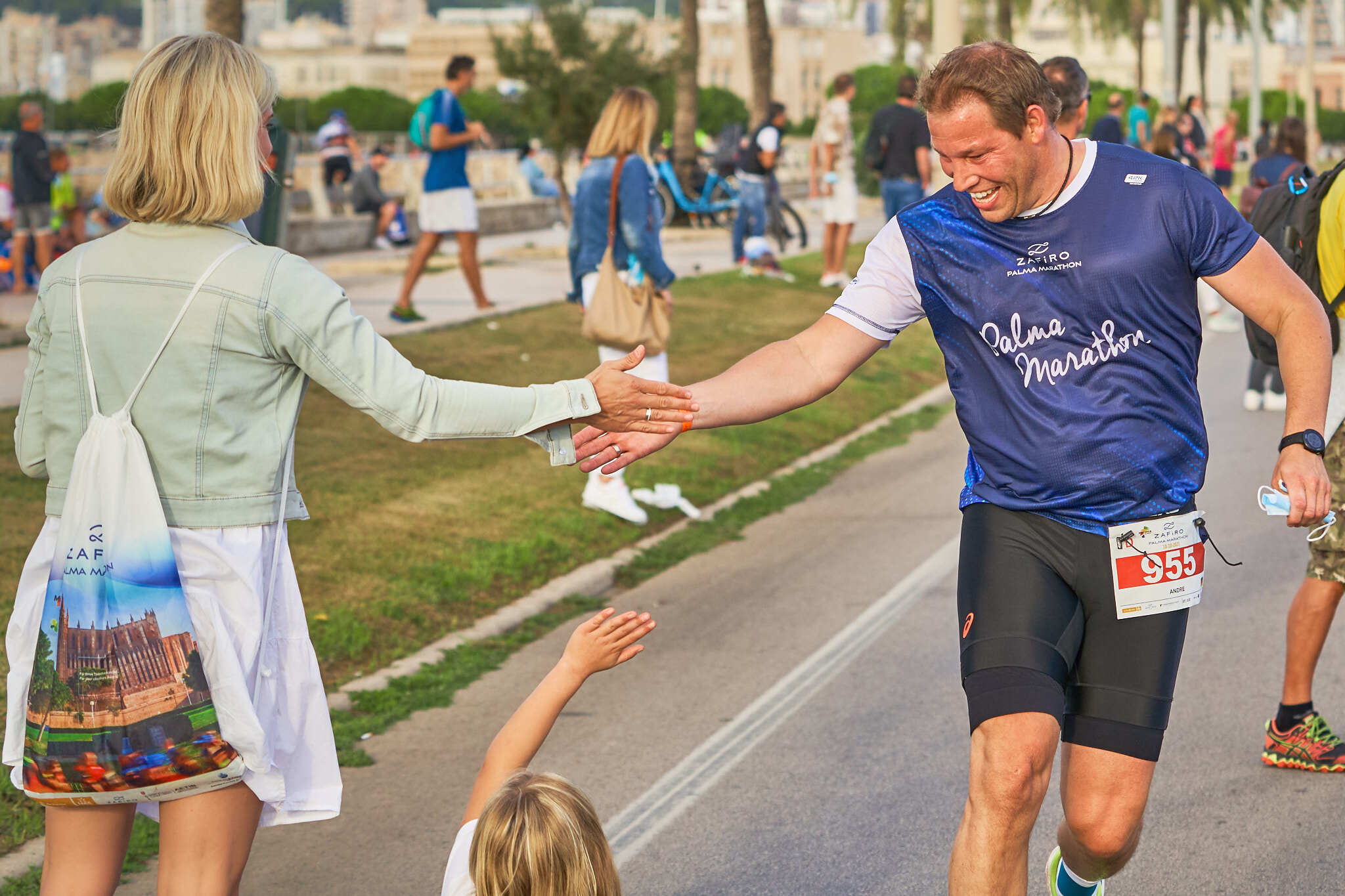
I hope these 10 tips for your first marathon are useful to you.

Health and kilometers!!!!
The COO (Chief Operating Officer) of 42KJulio Mas, was one of the more than twenty thousand runners who competed in the Athens Marathon on November 12 and has told us in first person about his experience in the oldest and also the most legendary marathon in the world.
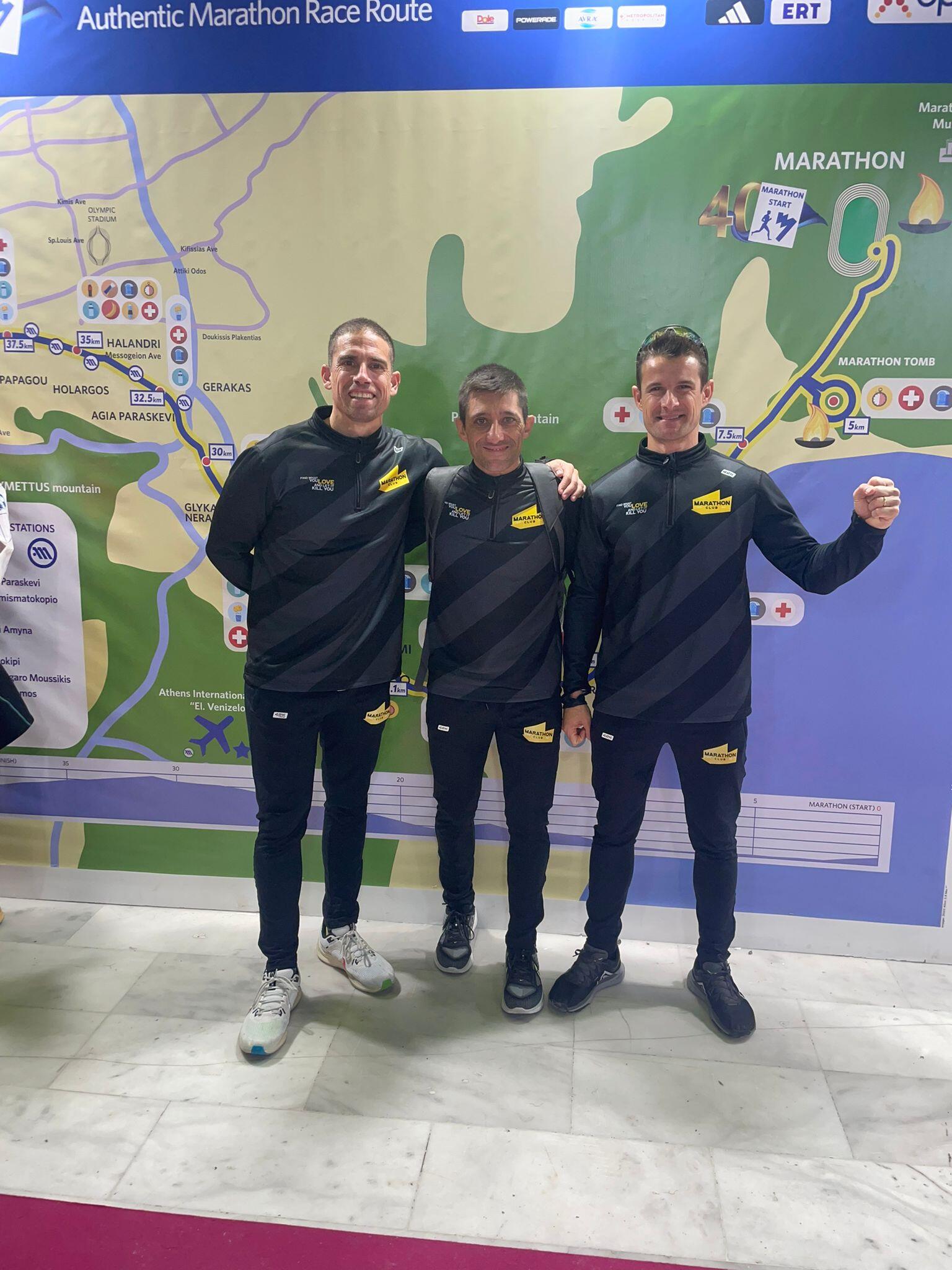
I started running about 30 years ago, at a time when the word “” was not used.running”, when at the start of any marathon in Spain there were no more than a thousand runners (and very few women) and when running through any city attracted attention and attracted looks of surprise and strangeness.
I have lost count of the races in which I have defended a number (I do not forget the first, the Volta a Peu València, when I was 14 years old), but I remember each of the marathons that I have run because I have put my soul into all of them.
The marathon is a unique test and I have always believed that it must be run with enormous respect and that, in my opinion, means doing it with the maximum personal ambition and with the determination to exhaust every last gram of strength.
I have completed the 42,195 kilometers 14 times and, fortunately, I have only experienced the disappointment and ingratitude of withdrawal once, in Seville (2014), although that is also part of the greatness of this test. Preparing for a marathon means training for months knowing that On race day you risk everything on one card and you are never safe from an injury, a fall, a stomach problem...
Competing in the Athens marathon, a dream come true after 30 years of running
I made my marathon debut in 2005, in Valencia. Since then this career has been part of my sporting life and also, to a large extent, of my professional life as commercial director of 42K, since our sportswear brand has been and is the technical brand of countless marathons in Spain, Italy, Ireland, Portugal, France...
I have been lucky enough to experience the marathon as a runner in wonderful settings: Valencia (eight times), Barcelona (twice), Paris, Rome and Stockholm. But ever since I fell in love with the marathon, I dreamed of one day competing in the legendary Athens Marathon.

After many years cherishing that dream, finally in 2023 I was able to be at the start of the town of Marathon to face the most historic, the most mythical and, without a doubt, the hardest of the great marathons. I'll tell you my experience in it. 40th Athens Marathon and I encourage you to one day experience firsthand the indescribable sensation of glory that is felt when crossing the finish line at the Panathenaic Stadium in Athens.
Athens Marathon, a unique atmosphere
The Athens Marathon It has the weight of history and legend behind it, something that is felt in the atmosphere that exists in the Greek capital in the days before the race. When you exchange glances with other runners in the most touristic places in the city, you realize that you share a mixture of excitement and nervousness, which is logically the result of knowing that you are in a mythical place and that you are going to face a unique marathon.

Athens turns to the marathon and you can breathe marathons throughout the city. It is their big sporting event of the year and they pamper it in a special way. The percentage of foreign participation is very high and that translates into enormous economic income for hotels, restaurants, commerce...
The Athenians experience the celebration of the race with joy and tremendous pride. They feel very lucky to be the origin of the authentic marathon; They like to breastfeed and remember that they are the classic marathon cradle, 'the authentic', as it appears on all the official posters and advertising of the event, and is even engraved on the finisher's medal (see in the photo).
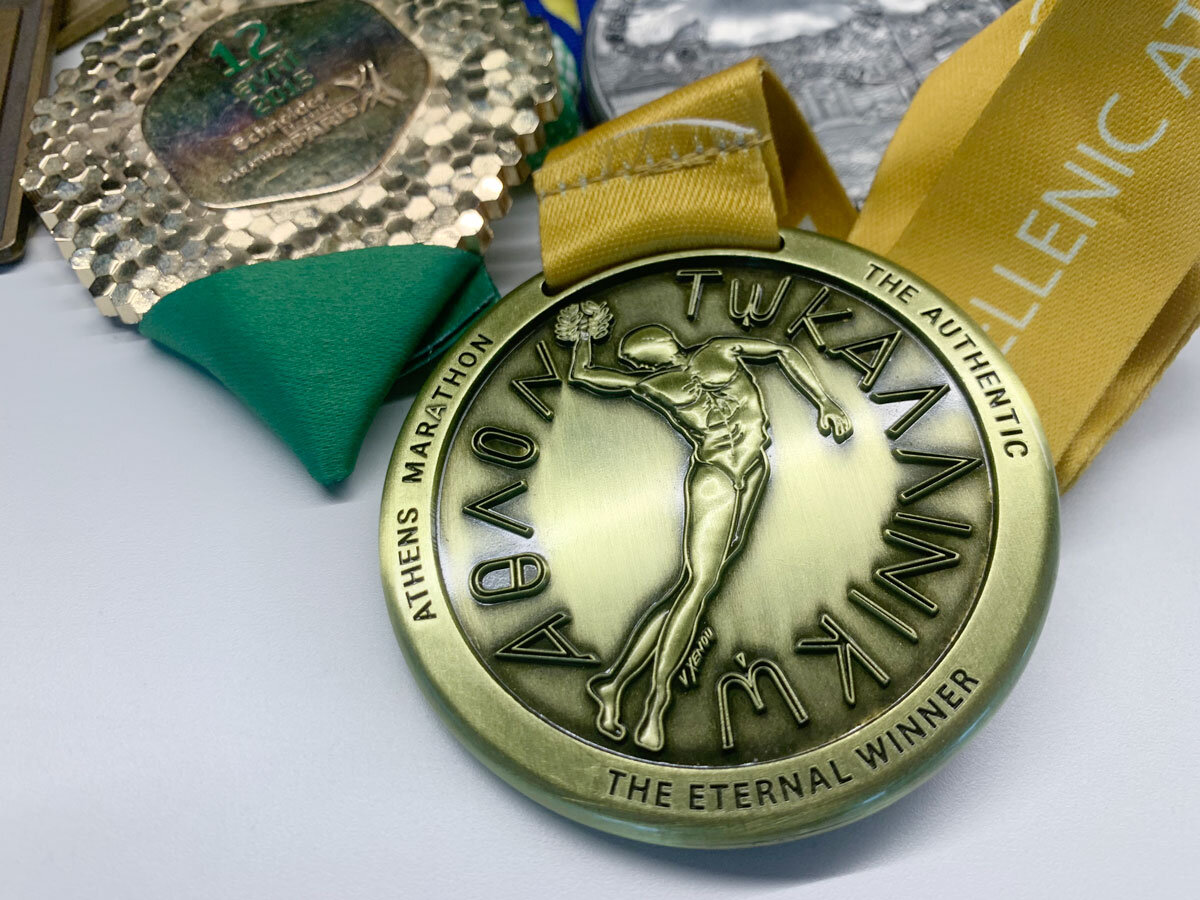
El first Olympic marathon was held in 1896 (one year before the Boston Marathon) on the occasion of the celebration in athens of the first modern Olympic Games.
History tells us that Pierre de Coubertin, who was the creator of the modern Olympic Games with the idea of remembering the Olympic Games of antiquity (held between 776 BC and 393 AD), received the suggestion of doing a long-distance race inspired by legend of the warrior-messenger Pheidippides, who ran from Marathon to Athens to report, just before he died, that the Greeks had defeated the invading Persian army at the Battle of Marathon.
The great atmosphere that exists in Athens is transferred to the spectacular runner's fair that celebrates the test. I have been to numerous important marathon runner fairs and I can assure you that the Athens marathon is one of the ones that impressed me the most. It installs at the Faliro Sports Complex, a grand sports facility that hosted the handball, taekwondo and volleyball competitions during the 2004 Olympic Games.
It is a fair in which you can spend hours and hours visiting stands of countless sports brands of clothing, accessories, gadgets... and in which many other marathons are also exhibited to attract participants, aware of the very high percentage of runners from all corners. of the world that meet in Athens.

An amazing and impeccable organization
Race day starts with a important early morning. You have to set the alarm very early to catch any of the hundreds of buses that take you to the starting line.
The device of hundreds and hundreds of buses that Twenty-something thousand runners are transferred from Athens but also departure in the town Marathon (marathon is the Greek word for fennel, a plant that was abundant in the area), which is found about 40 kilometers (the distance that according to legend Pheidippides traveled in the opposite direction).
From 5:30 in the morning the streets of Athens are abuzz with people and buses. It's a mammoth deployment of buses, perfectly distributed throughout different areas of Athens and with previously established departure times.
I have worked in race organization and I know the difficulties involved in organizing an event for more than twenty thousand people. It is very difficult to imagine the extraordinary complexity of organizing the bus journey from Athens to Marathon for more than twenty thousand people and doing it with such professionalism and in such a fluid manner.
I must admit that I did not expect to find a career with such a professional and efficient organizational level; all, absolutely everythingIs perfectly organized so that around 7 in the morning, two hours before departure, all participants are already in the town of Marathon.
Another example of perfect organization is the wardrobe that is installed at the exit. A huge team of people from the organization is in charge of collecting the bags and backpacks from the participants and they are immediately transported by trucks to the finish line in Athens, where a multitude of volunteers classify them by number to facilitate collection after the test.
The Marathon start, a moment of great emotion, excitement and nerves
We arrived at the town of Marathon at 7 in the morning and there are still two hours until departure. He atmosphere in Marathon It is spectacular: a mix of emotion, excitement and nerves. And that feeling increases as the departure time approaches. There is hardly any audience, but it is not missed because the animation of the test is responsible for generating enormous expectation and creating an atmosphere of great emotion.
I had the opportunity to talk to runners of different nationalities who were also making their debut in the race, most of them with many marathons under their belts, and all of them admitted feeling a special emotion, a mix of feelings that they had not experienced at the start of other big marathons.
When the time of departure is close, the organization's animation does not stop encouraging the participants. The moments before departure make your hair stand on end.
A unique route due to its hardness and demand
I had thoroughly studied the route and knew that I was facing a complicated and very demanding route. So it was. Without a doubt, it has been the hardest marathon I have ever run.
The first 10 kilometers are flat and they are completed easily, but from there the real Athens marathon begins. I remember going from the start behind two Greek runners who, upon reaching kilometer 10, high-fived each other and wished each other luck; They knew, probably because they were not beginners like me, at what exact moment they had to start gritting their teeth to face the race.
When you leave kilometer 10 behind, the road heads towards the sky. Until kilometer 31 the terrain is constantly ascending, with the occasional short section of descent that deceptively allows you to recover (keep a rhythm or a controlled pulse becomes impossible task). There are five thousand especially hard, from the 26th to the 31st, with very demanding ramps that require correct dosage of forces because it is very easy to make the mistake of forcing and pay dearly for it later.
From kilometer 32 the tour is softens because the descent towards Athens begins, but the difficulties are not over. To face the descent you have to be very strong quadriceps because otherwise you can have a very bad time in the last ten kilometers.
Between 34 and 36, you begin to notice very significant muscle fatigue, which is the result of so many kilometers of climbing and the change of support when running that requires you to make the descent. At that point in the race is when you are very grateful for having done specific strength work for this test.
The last kilometers can be tortuous, very tortuous, without adequate muscle preparation. At the Athens marathon the famous wall may be higher and more dangerous than in any other 42 kilometer race.
The Athens Marathon requires special preparation
The route approaches the 400 meters of accumulated positive slope and 80% of that climb is concentrated between kilometers 10 and 31. It is a marathon in which it's very difficult to pick up the pace, except in the first ten kilometers. There are sections of the route with very hard ramps that require a special level of physical and psychological preparation.
In my opinion, the Athens marathon It cannot be faced with the same preparation strategy as for a flat marathon. like, for example, Valencia or Seville. Without a doubt, you have to arrive with a very significant volume of kilometers in your legs, but I dare say that it may not be enough to be guaranteed of crossing the finish line in Athens. This race requires special muscle strength preparation and also extensive previous experience in marathon distance.
Without very well-planned strength work focused on the hardness of this race, the Athens marathon cannot be tackled safely. If you have any muscular weakness, it can be very difficult to finish.
Emotion overflows upon arrival at the Panathenaic Stadium in Athens
If I had to stay with an indelible memory of the Athens marathon, is without a doubt The entrance to the Panathenaic Stadium in Athens.
At kilometer 42 there is a curve that places you in front of the entrance straight to the stadium. At that moment the senses are not able to process everything you see and hear. The emotion overflows. Suddenly you see yourself running inside the most legendary stadium in sport. The stands are very high and are full of people applauding, cheering, shouting... You look up and feel overwhelmed with the spectacle. It doesn't matter how you imagined that moment: reality exceeds any expectations.
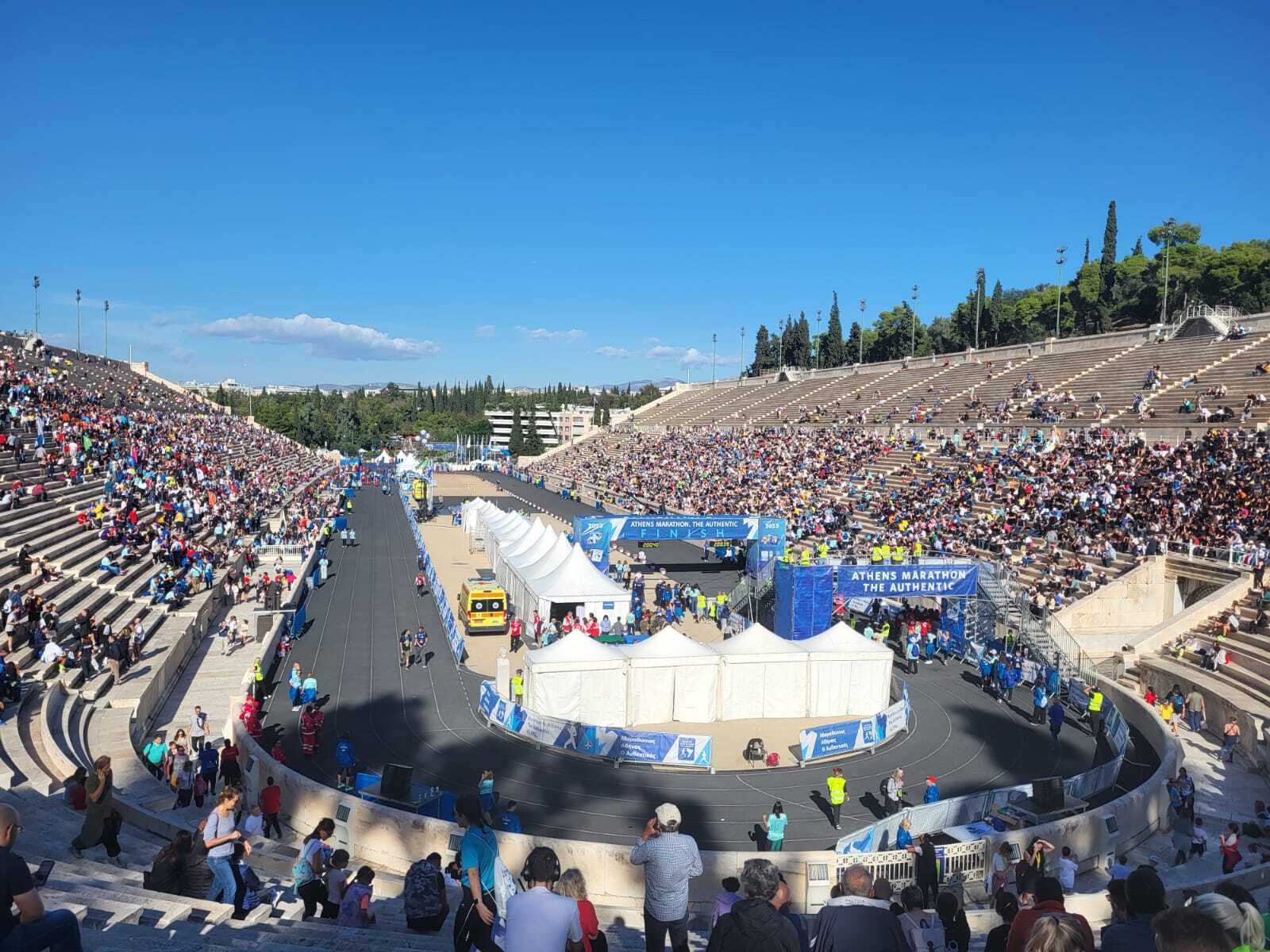
Panathenaic Stadium also known as the Kallimarmaro (what in Greek means "beautiful marble" because it is built with white marble), in 1896 it hosted the first edition of the Modern Olympic Games after having been rebuilt on the remains of an ancient stadium dating back to 329 BC
It is located in the center of Athens and is reached after a journey of about 2 incredible kilometers through the streets of the city. The number of people waiting in Athens for the arrival of the participants is incalculable. The emotion felt in those two kilometers neutralizes any feeling of tiredness, any discomfort. Everything you have suffered is compensated. Is the warmth of the Athenian public is impressive and how they encourage you to fly you to the entrance to the stadium.
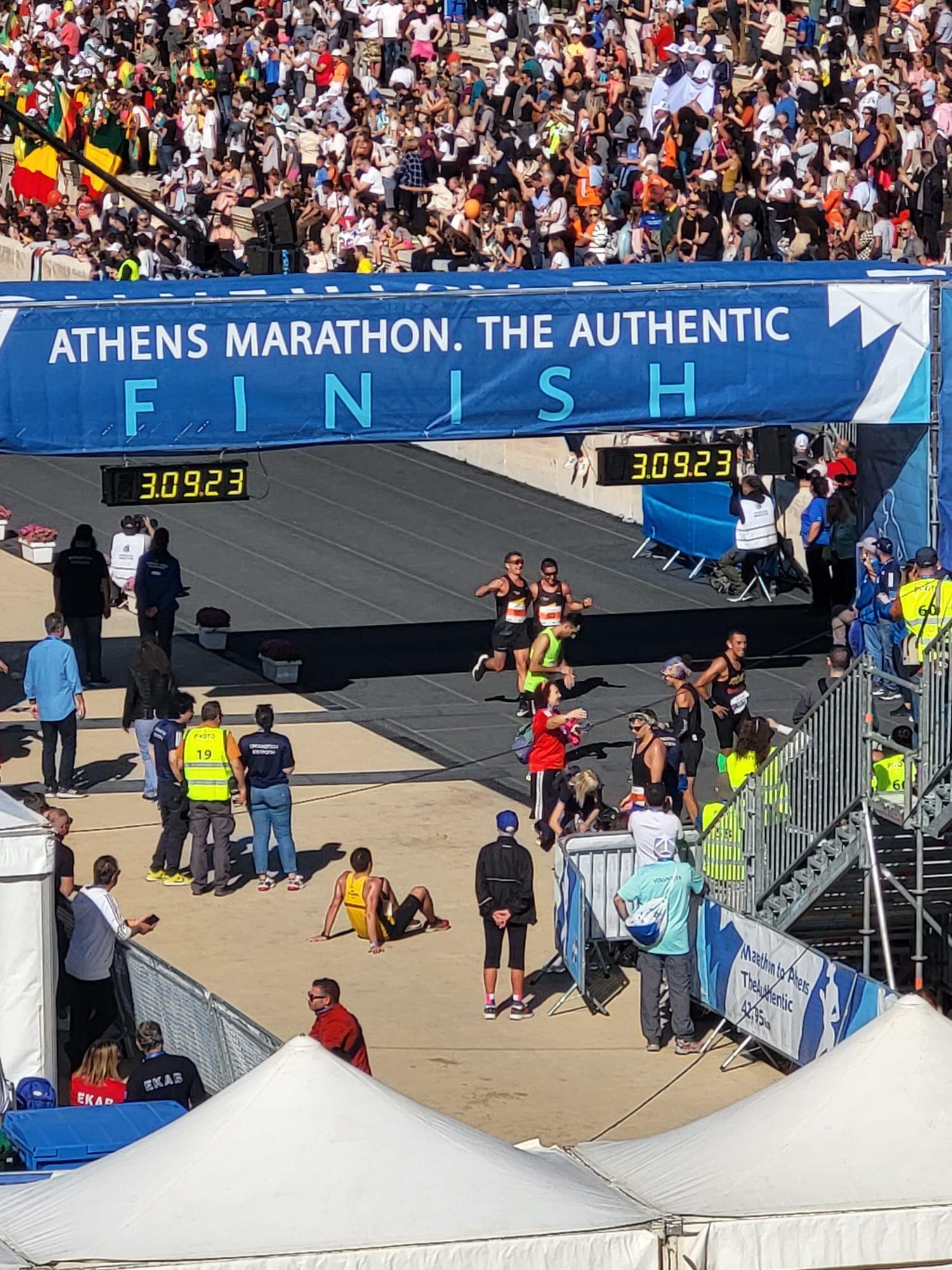
Athens is a marathon different from the rest of the big marathons
The Athens Marathon It is different from the rest of the big marathons in many things. Has numerous features that make it unique and some of them, in my opinion, reinforce their uniqueness and authenticity.
A priori it may seem less attractive because it has a series of “drawbacks” that do not occur in other large marathons: the huge early morning on race day, trip of almost an hour to Marathon, a tour with more than 20 kilometers of ascending terrain (the longest uphill hill in a marathon race) or run without an audience for most of the race.
In any large marathon, the presence of the public throughout the entire route is common, but in the Athens marathon this is not the case. There is an audience at the beginning, at the start of Marathon, but as soon as you leave this town and head towards Athens the race runs along a kind of national highway without public, except when passing through towns like Nea Makri, Rafina, Pikermi... in which all the inhabitants take to the streets to cheer with great enthusiasm, offering olive twigs as a way of wishing good luck, dancing Shirtaki, which is the Greek popular dance par excellence …
The public concentrates in the towns through which the race passes and at the end, in Athens, but there are almost 80 percent of the route in which one runs without public. Perhaps that may seem strange or be an inconvenience for someone used to running marathons with animation at every kilometer and with the presence of the public throughout the route; It seems to me that running alone for so many kilometers gives this race a special appeal.
The Athens Marathon forces you to face the true loneliness of the marathon runner, the famous distance runner loneliness. The marathon is a sporting event that requires mental strength and in a course like the Athens Marathon you test your mental strength like in no other marathon, at least like in no other that I have run.
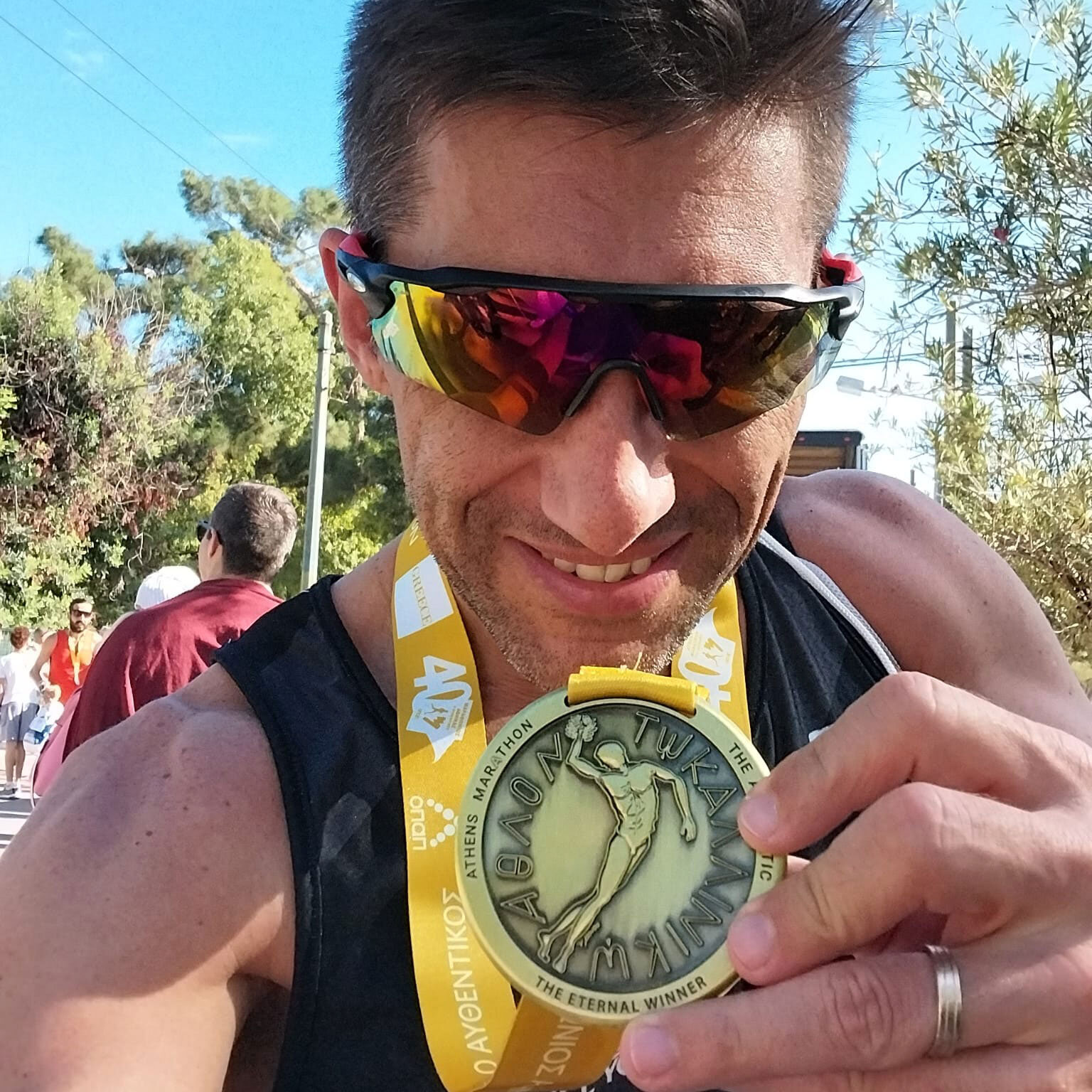
The times of Abel Antón and Martín Fiz in the 1997 World Cup, a feat
After having run the Athens marathon and having suffered its hardness and demands, I consider the times set by Abel Antón and Martín Fiz in the 1997 Athens World Championships a true feat, 2h 13m 16s and 2h 13m 21s, when they became champion and runner-up of the marathon world.
The records of Antón and Fiz in that world cup they are amazing. When you know the route you give much more value to what they did. It is a brutally demanding leg-breaking route. It seems almost science fiction to me to think about running at such high paces on a route like the Athens Marathon.
In all my participations in marathons I had managed to be sub 3 hours (except in Stockholm in 2018) and with that ambition I started the Marathon, but the race put me in my place. In the end I stopped the clock at 3h 09m, a time that I celebrate with the same enthusiasm as any of my best times (2h37m and 2h42m in Valencia 2013 and Valencia 2012, respectively).
I have fulfilled a dream. I have crossed off what has always been the marathon par excellence for me from my bucket list. I have lived the most exciting finish line of my life and i have accompanied by two great friends, Borja and Carles, to whom I am united by many races and many kilometers run, but from now on, we are also united by having lived together the experience of the great Athens marathon, the authentic one.
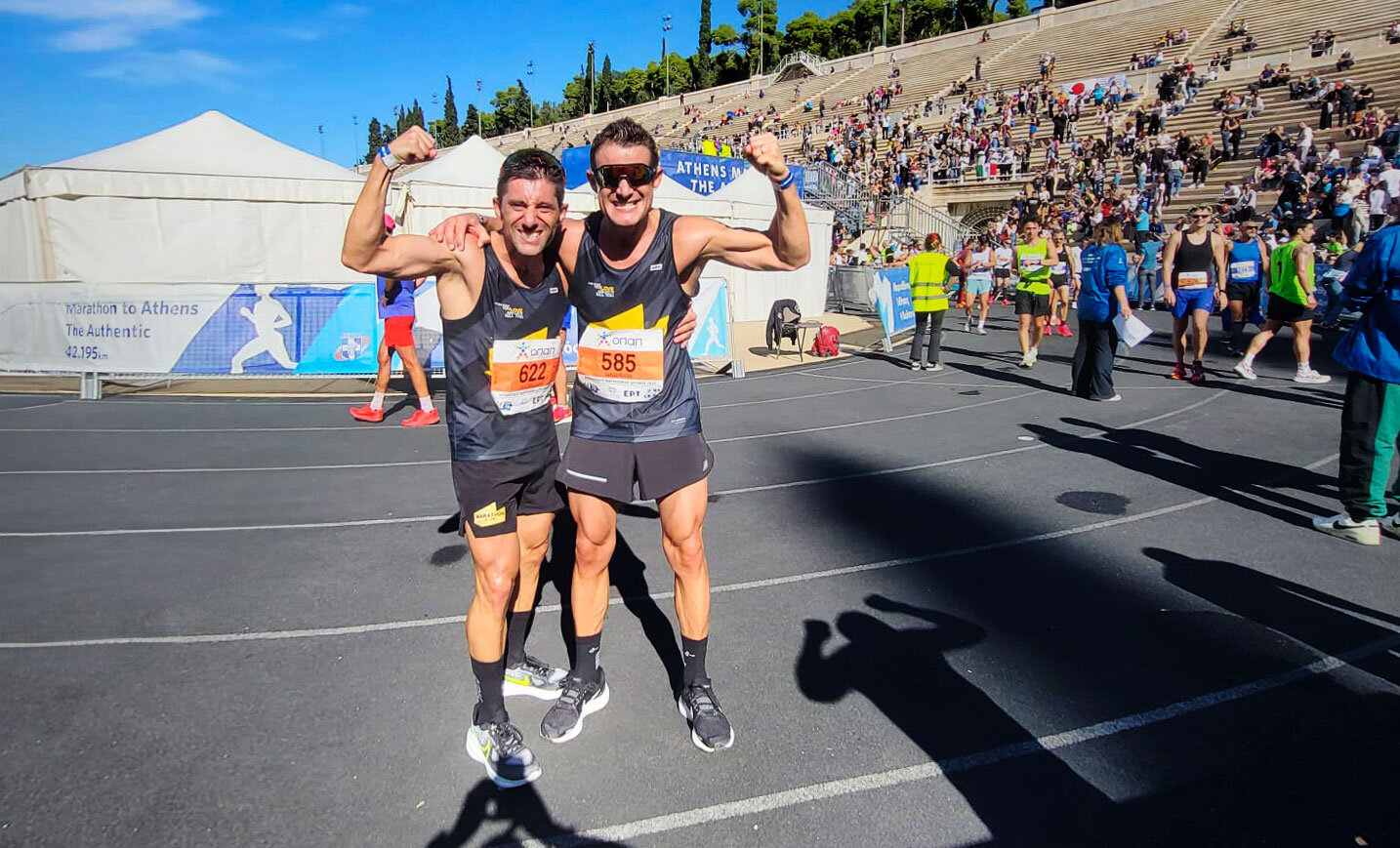
Two other great friends, José Luis and Chema, should have also experienced it, but due to different personal circumstances they could not. I hope and wish that one day we can form the five, as planned in 2023, at the Marathon starting line and face together the 42,195 kilometers with the most history. I trust that life will allow me to once again enjoy the unique experience of running into the Panathenaic Stadium in Athens.
I heartily encourage any runner who loves the marathon to dream of competing in the Athens Marathon sometime in their life.
- T-shirt running technique in black.
- Technical fabric Tri-Active elaborated with 100% recycled polyester yarn.
- Design with sublimated geometric drawing on the chest.
- Flat seams.
- Printed label Anti-friction.
- Ergonomic front pattern and back panel longer back.
- Seated style sleeve.
- Anti-friction cover seam placket on the neck.
- Logo 42K sublimate.
- Differentiated pattern for male and female runners.
- Treatment for fast dry “DRY-TEC+”.
- Transmission Anti-friction “SOFT-LIGHT”.
- Treatment for color fixation “DC4”.
TriActive is the name of a new 100% recycled technical fabric which is incorporated into the catalog of 42K to create t-shirts for running of the highest technical quality but also respectful of the environment.
This fabric, which is made with 100% recycled polyester, stands out for its incredible lightness y smoothness. Its lightness (a unisex T-shirt in size M weighs 104g) guarantees a excellent breathability and, therefore, the t-shirts made with this new fabric stand out for their quick evacuation and drying of sweat.
TriActive is the fabric that gives life to the new collection of t-shirts for running baptized with the name of Motion and will also be the protagonist in a new collection that will be released shortly. 42K prepares different novelties in terms of t-shirt collections and new technical garments for the coming months.
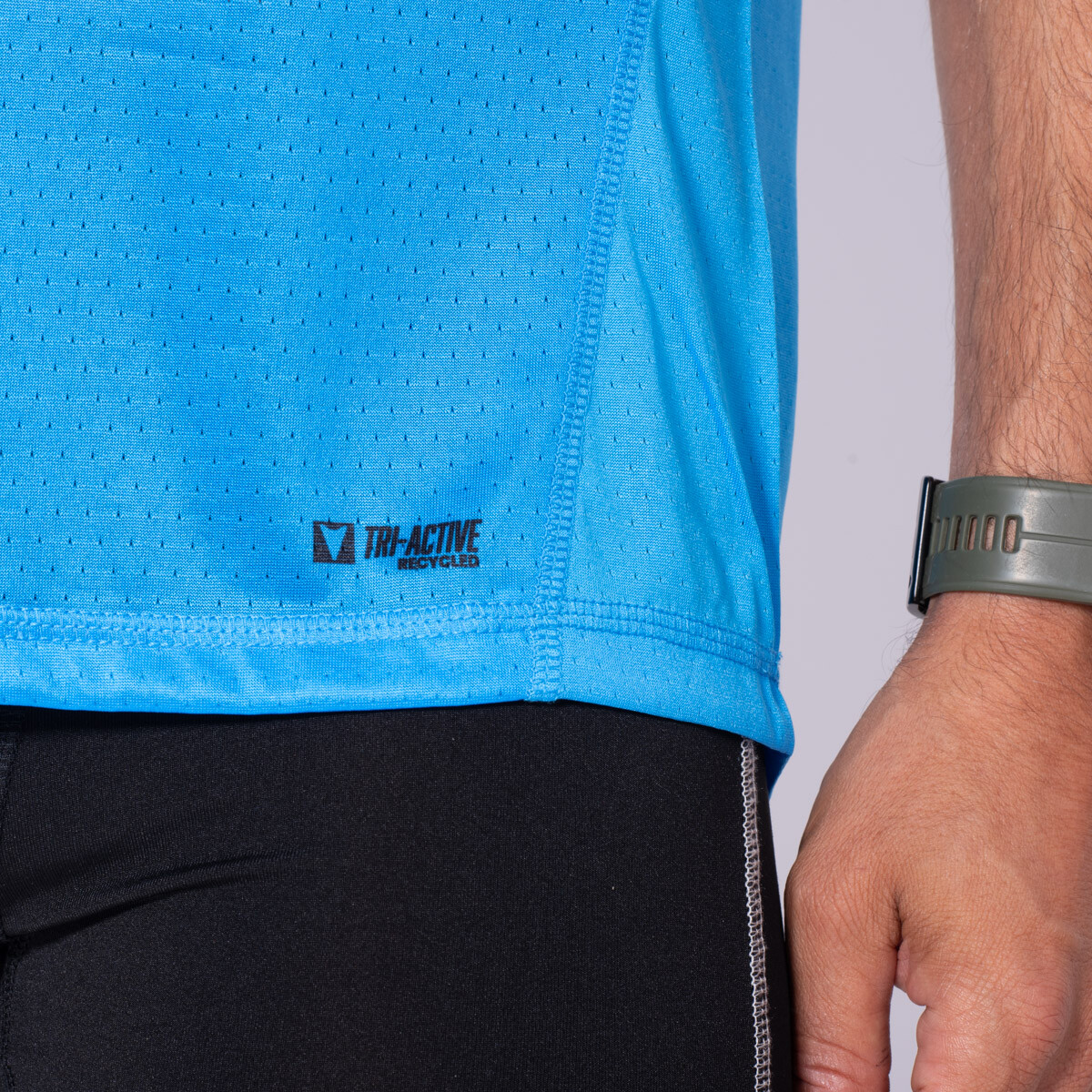
The TriActive fabric has the technologies 'Dry-Tec+', 'SoftLight' and 'DC4′ that improve their technical qualities for the creation of specific t-shirts for running and athletics. These technologies applied to the fabric guarantee quick drying, softness and color preservation.
TriActive & Infini_Tech, two 100% recycled fabrics
The arrival of recycled TriActive fabric reinforces the bet de 42K for sustainability.
42K account from 2020 with the fabric Infini_Tech, a technical fabric that is made entirely of polyester from the recycling of used plastic bottles. Different highly successful collections have been created with this fabric, such as Ozone, Elements y Elements Summer, three collections that have received numerous recognitions from runners in Spain and also from countries such as Italy, Ireland, Portugal or France, as well as from clubs and events.
Different garments from the section are also made with this fabric. Custom Line 42K, the business line dedicated to the production of 100% personalized technical garments using digital sublimation for athletics clubs, sports groups and groups.
Like Infini_Tech fabric, TriActive guarantees the construction of technical t-shirts for running of the highest quality, with excellent lightness and breathability features, but with great added value: a less impact on the planet.
One of the commitments 42K in its growth projection for the coming years is the commitment to sustainability and that is what has led to the incorporation of this new 100% recycled fabric for the production of new collections of technical garments.
Eating correctly is key to improving as a runner. It may seem obvious, but reality shows us that things are not always clear. It is very common to find runners with many doubts, erroneous beliefs or confusion about what correct nutrition should be to achieve adequate and correct sports performance.
Training is the basis of improvement in any sports specialty, but in order to obtain effective benefits from training, you must follow a correct procedure.limentation.
On too many occasions there are popular runners who care a lot about how to train to improve times or face the challenges of long-distance races, but they neglect or do not give due importance to proper training.limentation.
Eating correctly has benefits in health, sports performance and physical appearance
Why and why is it important to eat correctly? Eating correctly provides benefits in three very important areas, ordered according to their importance as follows:
- Health.
- Sports performance.
- Healthy physical appearance.
When looking for reasons or reasons to eat correctly we should always be clear that the main priority is health, secondly sports performance and thirdly having a healthy physical appearance.

Have some good nutritional habits It will provide benefits at different levels for health, sports performance and a healthy physical appearance. Let's see the most notable ones below:
Decreased risk of pathologies. With a good nutritional status, the chances of suffering from pathologies such as Hypertension, d, hyperuricemia, hypercholesterolemia, hepatic steatosis, etc.; and if they already suffer (and are not acquired through family genetic inheritance), it is possible to reverse them and make them disappear.
Health & Wellness. Reducing the risk of pathologies is promoting a optimal health for any patient (men, women, athletes, pregnant women, nursing mothers, the elderly, children, etc.), which represents a considerable increase in quality of life as well as economic savings due to lower spending on drugs.
Weight loss. Evidently, eating correctly following a correctly designed (and followed) diet, moderately hypocaloric in nature, has a loss of fat mass.
Increased muscle mass. A dietary plan proposed in harmony with the training plan established by a coach allows the athlete increase your muscle tissue. Eating correctly in combination with good training focused on the established sports objective will mean a healthy physical appearance.
Post-workout recovery. Eat correctly under correct guidelineslimentaria will help recover muscle glycogen stores, regenerate broken muscle fibers during training, etc. If a runner makes the mistake of neglecting his or herlimentation, you can end up showing wear and tear and the demands of training; without a correct alimentation, sooner or later, feelings of weakness or fatigue will appear, which will mean loss of sports performance.
Preparation of competitive appointments. Eating correctly throughout the season, and specifically the week before a competition (especially the day of the test) is essential for correct sports performance, whatever the sport practiced. The difference between getting on the podium or not, improving personal bests or finishing with more energy than rivals is in thelimeTraining (and at the training level, obviously).
Increased athletic performance. SlablimeThe things that are ingested are the gasoline that is provided to the body to make an effort (among many other functions). A supercar uses 98 unleaded gasoline, not diesel, so if you want to perform, you will have to give your body 98 unleaded gasoline, that is, a alimehealthy eating and perfectly designed based on sex, age, type of sport, work and training schedules, blood test results, pathologies, needs and tastes, etc.
Lesions decrease. It is clear that eating correctly will not prevent you from spraining your ankle while running because of a pothole or a rock, or it will not prevent you from dropping a dumbbell on your foot in the gym and causing an injury. However, a diet that provides the necessary energy, as well as the recommended daily intakes of all the essential nutrients, is capable of avoid the appearance of cramps or jerks, therefore increasing sports performance.
Eating correctly does not have to be confused with eating less.
Sometimes there is a false belief that eating correctly means eating less, but in reality what it is about is eating well.
When a person decides to lose weight (reduce fat mass) one of the first decisions they usually make is to cut back on daily calorie consumption. Is it a correct decision? The answer to this question requires a prior clarification: to achieve a weight reduction (fat mass) a negative caloric balance must be generated, or what is the same "burn" with physical activity more calories than consumed in the different intakes.
To achieve this negative caloric balance there are several ways:
- Reduce the amount of kcal ingested on a daily basis.
- Increase our daily caloric expenditure.
- Merge both options: cut back on intakes and increase physical activity
In most cases the best option is increase exercise and not just reduce calories without further ado. Although it is advisable to individualize and personalize each case (because each person may have personal and specific circumstances); In other words: what a runner says he or she does through their social reds cannot be generalized as what is ideal for anyone.
Reduce without any criteria the quantity and/or frequency of intakes can be harmful to health since you can fall into macronutrient (carbohydrates, proteins and fats) and/or micronutrient (vitamins and minerals) deficiencies. This is a bad decision because it can cause various damages: tiredness, fatigue, bad mood, hypoglycemia, anxiety, decreased athletic performance, anemia, easier to fall ill (the immune system is weakened), etc.
Furthermore, and as stated in another article on this blog Losing weight in the middle of the competition season can be a bad decision. It is not advisable to undertake a weight loss strategy during the competitive period because it will be difficult to obtain benefits and sporting performance will surely be harmed.
On the subject oflimentation to reduce fat mass (weight loss)The best advice that can be given is go to a registered dietitian-nutritionisto to be in charge of designing a dietary plan adjusted to the needs, lifestyle and sporting demands of each person. A dietitian-nutritionist will always look for the best option to allow the person to achieve their sporting goals but always having as the highest priority the improvement of health through correct nutrition.limentation.
Remember, it's not about eating less but about eating correctly. You can reduce body fat with something as easy as doing frequent physical activity and eating correctly: eating a healthy, varied and balanced diet in which no group of foods is eliminated.limentos (consume meat, fish, eggs, fruits, vegetables, nuts, legumes, pasta, rice, dairy products, bread...), but in which the foods are clearly limited.limeultra-processed nts.
Forget the 'beats'limentos'; eating correctly is eating everything in the right amount
If you are a popular runner and you care about your nutrition, you have probably heard of the term 'exceed'.lime'ntos'.
If we had to define what the exceedslimein it would be something like “those toliments that have the capacity to cover all the energy and nutritional needs of the individual.”
But does anyone believe that alimeHow much can it have the capacity to cover all the energy and nutritional needs of the individual? Well no. The term 'exceedslimento' should not exist, however we can talk about itliments that have “X” capacity on health.
Avocado is good for the heart and has been considered a 'superlimento'. Indeed, numerous studies conclude that adequate consumption of said alimento contributes to a good state of cardiovascular health, improving blood levels of cholesterol, triglycerides, etc. Does this mean thatlimeIs eating avocados good for your health? No; someone who only knowslimeIf you eat avocados, you will probably end up suffering from hypoglycemia and you will always be exhausted, anxious, hungry, etc.

Eating correctly is consume theliments of all kinds in their right measure. You should not abuse alimenot because they say it is good, nor radically avoid othersliments. Would you like to eat a donut one day? (not every day of the week)? Forward! Food is one of the great pleasures in life.
Therefore, rather than talking about surpassinglimewe should do it exceedslimentation, which would be defined as a style oflimentation in which all groups oflimein (dairy, bread, pasta, rice, legumes, nuts, fruits, vegetables, meat, fish, eggs, etc.) and allows the individual to achieve a correct nutritional and health status.
In other words: One tolimento, no matter how good it is, is not capable of covering all the nutritional needs of a person, while onelimeVaried and balanced nutrition allows the person to achieve the recommended daily intakes (RDI) and maintain an adequate state of health. Eating correctly is, in short, having alimeRich and varied nutrition that optimally covers the needs that we may individually have based on our age, sex, state of health and demands related to the physical activity we perform.
Gastrointestinal problems are one of the main risks (and fears) that runners face in background tests like the marathon, trail races running long distance or ultra-resistance tests (6H, 12H and 24H).
The appearance of gastrointestinal problems dDuring a competition it can spoil all the chances of achieving the desired sporting goal. Most runners have experienced the difficulties and annoyances representing running with gastrointestinal problems, especially when this happens in tests lasting several hours (as is the case of the marathon, racing mountaineering, triathlon events, duathlons, etc.) in which the intake of alimentos, supplements, liquids, etc. to maintain sporting performance and avoid the dreaded “birds" as the hyponatremia.
Between 30% and 50% of runners suffer gastrointestinal problems in long distance events
Alimenting and hydrating correctly is necessary, essential to be exact, in races of a certain duration, but it is of great importance to do it correctly to avoid the appearance of gastrointestinal problems, which tend to be, as already indicated, very common.
Studies show that between 30% and 50% of the participants in long distance tests suffer from gastrointestinal disorders or problems. Fortunately, the majority manage to complete the course with more or less success, but it is also true that sometimes gastrointestinal problems can force abandonment because they trigger more serious consequences and put the athlete's health at risk.

We present below some of the most common symptoms gastrointestinal problems What runners can suffer during a long-distance event (and I am sure that the vast majority of runners have suffered some of these gastrointestinal problems at some point):
- Refluxes/burning.
- Eruptions.
- Distension/swelling.
- Stomachache.
- Nausea/vomiting.
- Intestinal cramps.
- Stabs.
- Flatulence.
- Gases.
- Urgency in defecation.
- Diarrhea
- Intestinal bleeding.
Running for hours with any of the gastrointestinal problems listed can be, at best, uncomfortable, although the discomfort can turn into major complications (lack of strength, dizziness, anxiety, abdominal pain, cramps...) and even lead to make the aspiration of crossing the finish line extremely difficult.

Main risk factors for gastrointestinal problems
Some of the gastrointestinal problems mentioned can be prevented. There are a series of factors that increase the risk of suffering from these disorders. Listed below are the main risk factors to suffer from these disorders in long-distance runners.
- Age. The appearance of gastrointestinal problems is more common in young athletes.
- Sex. The appearance of gastrointestinal problems is more common in of (especially during the menstrual period).
- Training level. The appearance of gastrointestinal problems is greater in athletes during their period of initiation to the competition.
- Pre-event intake. To avoid the appearance of gastrointestinal problems, it is recommended avoid fat and fiber. Consume carbohydrates (not whole grains) and protein. (This point will depend on the tolerance of each individual).
- Caffeine. It may be important for performance, but it is necessary control doses pre-competition and during the test, or even divide them into 2 shots.
- Dehydration. It usually occurs in the final part of races and is related to the appearance of gastrointestinal problems. Replace fluids and minerals It is essential during the race to avoid the dreaded dehydration that can destroy all hopes of reaching the finish line.
- Consumption of gels, bars, rehydration drinks,limein, etc. Must be test exhaustively in training individual tolerance of each and every product that will be consumed on the day of the race. On the day of the race you cannot do experiments: all thelimeThe liquids and solids consumed must have been previously tested in training to know how the body tolerates them.

Recommendations to avoid gastrointestinal problems
The following recommendations are of a general nature and may vary according to each athlete, type of sport, duration and intensity of the event, weather ... But they are a factor to take into account to prevent gastrointestinal problems:
- Always try the strategieslimentation and hydration in training and never on the same day of the race. If the sporting goal is a marathon, my recommendation is to try the strategy oflimentation and hydration in training and if the result is satisfactory, then try it in a test prior to the marathon that we have as our objective. Once we have ensured that it does not cause us any harm either in training or in competition, we can carry out the strategy in the objective test without fear of the appearance of gastrointestinal problems.
- Carbohydrate intake. ingest 60-70g of carbohydrates (HC) for each hour of competition. This amount can reach 90g HC / h according to the tolerance of the individual. In running races, the intake of 40-60g HC / h is recommended.
- Hydration. ingest 500-700ml of liquid per hour.
- Sodium intake. Take between 250-350mg sodium per hour. Replacement gels, capsules or drinks are some of the possible ways to consume it.
- Caffeine. Consume between half an hour and one hour before the start of the test. 2-3 mg of caffeine per kg of body weight (For example a 70kg runner will consume 140-210mg of caffeine in the test). If the race lasts more than 8-9 hours, this amount can be repeated every 3-4 hours.
- Consumption of supplements. Bars, gels, replacement drinks, etc. They are a great way to obtain carbohydrates, liquid, caffeine and minerals due to their easy consumption, digestion and absorption. Note: supplements in gel format should be taken with water to facilitate swallowing and dilute the concentration of sugars.
42K · All rights reserved
